History of Soviet Aviation. Polikarpov P-1 - the first serial Soviet aircraft
"ILLEGAL BIRTH" "DE HEWILLAND"
The famous English aircraft designer Jeffrey De Hevilland during the First World War, designed the successful multipurpose biplane DH.4. It was produced in large quantities and used at the front. The machine was also interested in the Russian military department, which ordered 50 copies and purchased a license for it. In England, 1917 was brought from England to Moscow in August with drawings and specifications. However, the documentation set was incomplete. 30 September 1918 already ordered the red air fleet to the Moscow factory Dux (renamed the State Aviation Plant No. 1 or GAZ-1 in the same year) to manufacture 70 machines with existing Italian FIAT A-12 engines in 260 hp. The first batch of machines had to leave the shop in the middle of 1919, and the entire order was required to be completed by 1 in May of 1920.
Originally on the DH.4 stood the English motor Siddley "Puma" in 230 hp It was necessary to prepare the missing drawings of the airframe and adapt it to another engine. The technical office of the plant counted just 11 people, so almost all of the company's engineers were involved in the work. Led the design N.N. Polikarpov.
In July 1919 the first plane was actually assembled. But he had many defects. The work of the enterprise by this time was almost paralyzed. Two consecutive revolutions and a civil war caused devastation, famine and the collapse of the economy. Not enough fuel, metal and quality wood. Imports ceased. In addition, illiterate Soviet leaders initially attributed aviation industry to the lowest supply category. Workers fled to a village where they could feed their families.
Only in May 1920, the first "de Havilland" could bring to mind. The first flight on it was made by the pilot GN X X of June. After 2 days, the second DH.13 took off. In total, by September 4 built 1921 machines, and by the middle of 26 their number reached 1923. Some of them were equipped with Italian FIAT engines with power 60 hp.
By the end of the First World War, the British aircraft received a new aircraft, the DH.9, which was a further development of the DH.4. Especially high data had the DH.9a variant with the American 12-cylinder Liberty engine. In Russia, such machines appeared in 1919 along with British aviation units that arrived to help the white armies. They were used in the battles of Tsaritsyn and in the north. After the evacuation of the English invaders, the White Guards left the technique. During the offensive at the Northern Dvina, the Reds captured one “de Hevilleland”. Valuable trophy sent to Moscow; he was accompanied by mechanic Sergey Ilyushin, later a famous aircraft designer.
After the end of the First World War in the countries of the Entente in the warehouses turned out to be many no longer needed combat aircraft, engines, various equipment and equipment. All this was ready to sell, and very cheap. The Soviet government took advantage of the situation and launched purchases in the West. In December, 1921 signed an agreement with Aircraft Dispozal Company for the supply of 40 DH.9 with Pumas. These aircraft began to arrive by sea through Petrograd from June 1922. Then, several more batches of DH.9 and DH.9a were purchased with and without motors.
They were collected in different places. In particular, the aforementioned GAZ-1 assembled the first car somewhere at the end of 1922; She flew the pilot Savin. Total by the middle of 1923 in Moscow released 16 DH.9. These planes were sometimes later called “P-1 English” in the documents.
But the assembly of aircraft purchased abroad was not limited. Back in the fall of 1918, they planned to switch to the production of aircraft with Liberty engines. In reality, the development of modifications based on DH.9a was taken up in May of 1922. The available DH.4 drawings were checked with samples of DH.9a.
The military intended to obtain, if possible, an exact copy of the English biplane. But the designers of the plant, headed by N.N. Polikarpov believed that he was far from perfect. They took the initiative to create a modernized version. The RKKVF administration did not show much interest in this idea, believing that the plane was still outdated and unlikely to be built in large quantities. Here they miscalculated a lot - the new machine, called the P-1, was almost the most popular in Soviet aviation for almost 10.
Of the parts complained about the lack of strength DH.9a. Designers made changes to the fuselage, fenders, boar strut, engine mount, engine hood, radiator and chassis. Applied a different wing profile. Fuel tank capacity increased by 20 l - by one pood. The only thing that has remained completely unchanged is the tail.
The domestic version of "de Havilland" received the designation P-1 ("scout - first"). RKKVF gave an order for this car in January to 1923. The assembly of the first “trial” P-1 was started in February, rolled out to the airfield in April, and flew around in May. After that, the aircraft was operated for a while at the Central Aerodrome.
FIRST SERIES
The development of the production of new cars on the GAZ-1 was led by well-known aircraft designer D.P. Grigorovich, who was then the technical director of the enterprise. In general, the P-1 can be considered the joint brainchild of two designers - Polikarpov and Grigorovich (plus, of course, De Hevilland).
The first two aircraft solemnly handed over at the Central Airport 23 June 1923. These cars were made on the model, which was considered temporary, and closer to the original "de Hoveland."
With materials it was difficult, they used what they could get. The American sprews, which remained from the pre-revolutionary times, and the Russian pine, both properly dried and half-dried, which were dried right at the factory, went into action. The gradual replacement of wood made it necessary to recalculate the aircraft for durability and even slightly change the design of the machine. The metal was also first used pre-revolutionary; then it ended. Since December, 1923 did not regularly receive his small batches. Steel was of poor quality, because of this, the axle of the wheels was made double: inside one pipe another was placed, of smaller diameter. The factory got away with it, as there were no technical conditions for the materials.
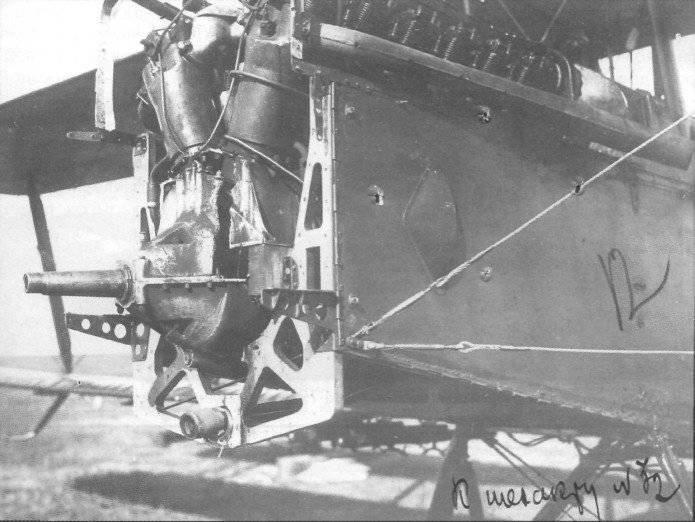
It was necessary to make radiators and ribbons for braces. There were not enough wheels - they were rearranged from one car to another to try on.
As a result, the productivity of the enterprise by January 1924 fell from 20 to six aircraft per month. Later, it ranged from eight to 14 machines. Fluctuations due to interruptions in the supply of components. The workshops were idle, then they were working feverish overtime. Constantly lacking engines "Liberty". The plant could not hand over the finished aircraft. The head of the aircraft building department of Aviatrest, K.V. Akashev reported that "the plants were faced with the need to completely suspend the assembly of vehicles because of the loading of all the free areas of workshops, warehouses, hangars and other finished products that could not be handed over to the customer due to the lack of engines." On GAZ-1 without engines stood around 100 machines, mainly P-1. Turned into warehouses assembly, painting and wallpaper workshops. With the same purpose, they rented a hangar from the Dobrolet at the Central Aerodrome. In June, nine previously manufactured aircraft rolled out to 1924 at the Central Airfield and stopped assembling the P-1.
Their official delivery was carried out from 15 on August 1924. The military handed over 10 machines (instead of 42 according to the plan), after which a UVVF telegram came, demanding that the acceptance be stopped: all planes were unarmed. The machines were only imported turrets without machine guns.
In June, 1924 completed the draft version of the machine, in which the frontal water radiator was replaced by the then fashionable cylindrical “Lumblen”. The project was reviewed at a meeting of the Scientific Committee (NC) at the UVVF. By this time, the prototype had already been built at the expense of the plant; 30 June it tried to start the engine. Almost immediately began to overheat. We decided that the performance of the water pump does not match the radiator. Redid the pump, then put the enlarged radiator. But it was not possible to bring the version with "Lamblaine" to the required reliability. P-1 to the very end kept the old-fashioned frontal radiator, characteristic of DH.9a. It can be added that on other planes where the Lambleins were installed according to the project, such as TB-1 or Р-3М5, cylindrical radiators "did not take root."
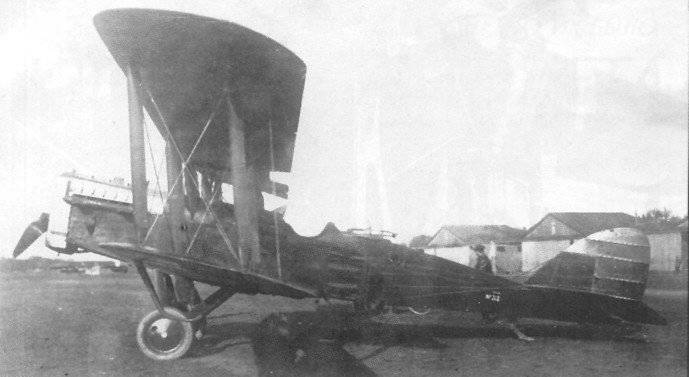
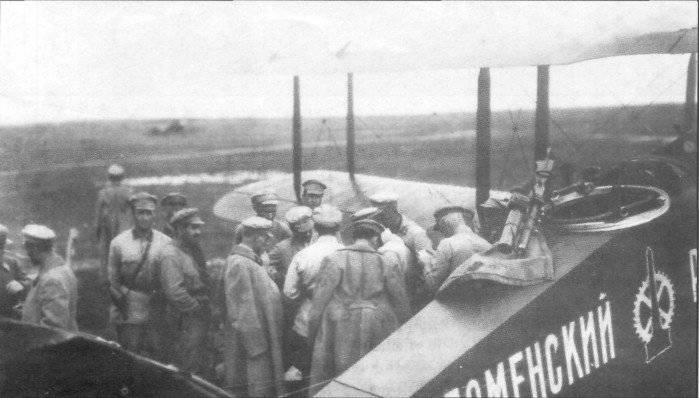
"PLANTS HAND OVER FLYING BOXES ..."
By the middle of 1924, the release of the P-1 was almost a deadlock. On the one hand, the air force needed new aircraft. On the other hand, no one knew what those planes were supposed to be. Firstly, there were no engines. Domestic factories produced only their outdated types, and even then in very small quantities. Delegations that negotiated with various firms in Germany, the Netherlands, France, the United Kingdom and the United States sent abroad.
Secondly, since June 1923, customers have demanded the installation of weapons on aircraft. But nothing like standing on the DH.9a in Russia was not released. Leadership Aviatress honestly admitted: "Plants rent flying boxes that have minimal combat value."
The situation with the engines cleared up only by the beginning of the autumn of 1924. It was only in November (although the planned year began on July 1) 1924 of the UVVF was determined with the orders to Aviatrest. Not “putting all the eggs in one basket”, we decided to purchase 40 machines from Liberty, as many with French engines Lorrain-Dietrich and 90 with English Siddley Pumas. The first two points were assigned to the GAZ-10 Taganrog plant, and the last to GAZ-1. But in practice, the situation with the supply of engines was such that the aircraft with the engines "Liberty" continued to build both companies.
These engines were bought in the USA and the UK. Approximately 20 units per month came from America, from England - from 10 to 50. By July, 1925 from overseas imported 106 engines. They were cheap, but they were sent directly from the warehouses, where they lay for several years. In Moscow, they had to sort out. Necessary parts purchased in the United States and the Netherlands. Motors in England were sorted out, adjusted and tested before shipment; they could immediately put on the aircraft.
In the absence of weapons and equipment on the aircraft, the military was partly to blame. The fact is that in the requirements for the supply there was no specific list of complete sets of machines. Moreover, there were no approved models of weapons and equipment.
Only 7 in January 1925 of the UVVF approved an agreement with Aviatrest on the composition of weapons and equipment of aircraft of various types, including P-1. In this document, for each machine were lists of equipment, but without specifying the types, systems or manufacturer. For example, "compass" or "clock."
As on the DH.9a, the P-1 was supposed to have a fixed exchange gun "Vickers" (we called it "Vickers" Sample 1924) outside the port side. It was attached to metal shoes mounted on wooden unequated brackets. Power machine gun - tape on 500 cartridges. In warehouses there were “Vikkersy” English caliber 7,69 mm and converted in Tula under the 7,62-mm cartridge for the Russian “Maxim”. Since the machine gun was firing through the screw rotation disk, a synchronizer was required. On the P-1, they were successively replaced by several types.
The first 1924 spring appeared the D-1 synchronizer (PUL-1), designed by engineer Saveliev on the basis of the design used on Russian-made Newport fighters. In comparison with the “Newporovskiy” synchronizer, PUL-1 turned out to be much more complicated, since the engine of the P-1 was much farther from the machine gun. They did PUL-1 in a big hurry - hurried the UVVF. The synchronizer was manufactured in a prototype and tested. It turned out well, but no more. The designer himself considered the synchronizer undiscounted. Military PUL-1 accepted as a temporary type and agreed to mass production. They made 210 (according to other data - 249) copies, and spent on it all the pre-revolutionary stock of high-quality steel. PUL-1 was put on the aircraft of both plants, but was soon recognized as unsuitable for combat conditions.
Machine guns began to be mounted on planes from the end of the summer 1924. Plant No. 1 also “retroactively” sent in parts kits for the revision of previously released Р-1. So, in October of the same year 25 sets shipped 1-th light bomber squadron to them. Lenin. Mounting them on airplanes was supervised by a factory mechanic.
But the temporary version did not last long. 21 August 1925. Aviatrest announced a competition for the best machine gun installation with a synchronizer for the P-1. In response, a number of designs appeared. D-2 (PUL-2) was manufactured as a prototype back in March 1925, tested and rejected. More successful have turned out D-3 (PUL-3). It was an original design, created specifically for the P-1. The prototype has passed a long test in the dash. First, 8 hours of shooting (intermittently) in the presence of NK representatives, and then another 2 hours - for the commission of the military department. 13 may 1925 g. PUL-3 approved as the standard type, and then released the first series of 30 copies. In June, they began to put on the P-1. But, unlike the prototype, serial synchronizers did not work properly. The reason lay in poor quality steel used in their production. Designers have identified defects and proposed an improved version, PUL-3bis. He passed the test and 15 October 1925 was launched in a series. Total released a few dozen PUL-3bis.
The original synchronizer PUL-3, designed by NP, competed with PUL-6bis. Tryapitsin. It included about a third less parts and was lighter on 1,5 - 2 kg and easier to manufacture. This device was successfully tested and 29 October 1925 was taken to production. The first PUL-6 appeared at the Moscow P-1 at the end of 1925. With 1 in January 1926, the release of PUL-3bis was stopped, and the Kovrov plant was connected to the release of PUL-6. From October 1 of the same year they were put on all planes assembled in Moscow.
All the types of synchronizers mentioned above were purely mechanical. But on GAZ-1 they experimented with other types. Engineer Saveliev designed the electropneumatic D-5 (PUL-5). He passed the factory tests, but his reliability was considered insufficient, and the cost - excessive. The simple and reliable PUL-6 completely satisfied the customers.
When shooting from a course machine gun, the pilot took aim. To do this, in front of the visor cab set the simplest sight design Vakhmistrov - ring and front sight.
Since the summer of 1925, on Р-1, instead of imported steel, domestic TOZ turrets of the Tula Arms Plant have been mounted under a single Lewis machine gun arr. 1924 G., copied from the French sample. The plant handed over planes without machine guns and sights on turrets; they manned the machines already in combat units.
The UHVS could not decide for a long time what a rear-mounted ammunition should be - six or eight disks of 47 cartridges. And it depended on what would be the cassette in the plane, where they were laid. Finally, they decided that six is enough.
In August, 1925 was the first to install a modified TOZ turret with a fork for twin Lewis machine guns on aircraft No. 2533, which NK soon approved. The plant was taken in five to seven months to deploy mass production. In reality, the turrets with twin machine guns began to be mounted in Moscow and Taganrog in October, 1926 g. The twin unit was relied on with eight-disc ammunition, later it was increased to ten.
P-1 was to be used not only as a scout, but also as a light bomber. Earlier on Russian airplanes, bombs were simply piled into the cabin of a Letnab, and then thrown off by hands, aiming at the eye. On the "de Heavilland" under the lower wing and fuselage were bomb racks; bombs were dropped by mechanical bombers. At the same time letnab pulled the handle and through the system of cables and blocks, opened locks, which liberated bombs. Aiming carried out the same letnab with the help of a simple device, hung outside on board the aircraft. Similar equipment was planned for the P-1. It originally provided for bomb armament from the under-beam D-3 (later renamed DER-3) and the ventral D-4 (DER-4). The beams allowed the suspension of the tandem bombs - in front of the lighter fragmentation, behind-fuse. The first batch of 30 sets of DER-3 on GAZ-1 was done at your own peril and risk, without the approval of NC.
The dumping was to be carried out by SBR-5 or SBR-7. Both of them, designed by engineer Gorelov, were variants of the British mechanical throwers of the Browning company, captured as trophies during the Civil War. They allowed the dropping of bombs one by one, a series with a given interval or a volley. Later, SBR-5 rejected. An alternative was the design saver of the Saveliev SBR-3, which was simpler, but provided only a single discharge or a salvo.
11 June 1925, a commission chaired by Vakhmistrov conducted an inspection and testing of bomb weapons at one of the P-1. This machine was specifically designed for experiments with weapons, so there were three different bomb spreaders on it at once: for the left wing, Savelyev, for the right wing, Gorelov and a single (SBR-1) for the ventral suspension. The UVVF did not approve the test report, did not agree with the findings of the commission, however, 30 June already ordered several types of bomb racks and throwers of small types.
By the summer of 1925, bombing sights existed only in prototypes. There were two types of them: Nikolsky (like the English “Vimperis”) and the simplest Nadashkevich. Later, each of them was made in 25 copies for thorough testing. The preference was given to Nadashkevich’s simple sight, adopted as AP-2. It was attached outside on the starboard cabin of the Letnab.
A full set of bomb weapons, called the Bombre-1, first put on an 2741 aircraft in September 1925 g .; This car was tested in October at the proving ground near Serpukhov, where the Air Combat School was located. The kit included DER-3bis, DER-4 and SBR-7. Tests conducted by a commission headed by Nadashkevich. In all flights, the car was piloted by K. Artseulov, and in the rear cockpit the members of the commission alternated - Nadashkevich, Dyakonov and Seleznev. The Bomb-1 Kit was officially approved on December 19 1925.
The first 37 Р-1, manufactured in Moscow according to the 1925 / 26 plan, did not have any bomb emitters or wiring to them, and the bomb holders were inoperable due to the lack of a number of parts. The following nine cars also did not have time to get bombers. Bomb sights were missing. All the missing was then sent by the plant in part "retroactively."
Since September, 1925, the UVVS refused to accept aircraft without a full set of weapons. Further, all P-1 were completed with Bombre-1. Heavy (by the standards of the time) bombs in 16 and 48 kg for reasons of centering were hung only on DER-4. On the DER-3bis, both front and rear locks tried to mount ammunition no heavier than 10 kg. It was recommended, whenever possible, to carry the entire bomb load under the wings. The range of the P-1 with bombs and a set of three machine guns was 275 - 300 km.
In January, X-NUMX P-1925 production began to be mastered also at the GAZ-1 Lebed plant in Taganrog. As in Moscow, the first six cars were released without weapons, then the UVVF allowed to hand over ten more of them. Later in Taganrog they introduced the same small arms and bomb armament as in Moscow cars. First mounted synchronizers PUL-10bis, since the summer of 3 - PUL-1926.
The transition to the production of fully combat-ready P-1 was highly appreciated by the Revolutionary Military Council: “In the field of aircraft manufacturing, the aviation industry finally entered the stage of mass production of the P1-M5 combat reconnaissance ...”.
The effectiveness of the use of P-1 as scouts and spotters could be improved by equipping them with radio communications and cameras. But special aviation radio stations in our country were only then designed. I had to use the lightest of the available samples, designed for cavalry. From the middle of 1925, the planes were produced with the expectation of the possible equipment of the radio station AK II. This station weighed 34,5 kg and made it possible to communicate with another aircraft at a distance of 2 km, with the ground - by 25 km by telephone and 200 km - by telegraph. The antenna was a discharge cable with a weights, letting it winch from the Letnab cabin through a hole in the floor. Electricity was given by a generator with a windmill on the lower wing and a battery. The plant mounted on the mass-produced aircraft a radio counterweight of the antenna and a seat for the radio station, but there were no stations themselves.
In June, the 1925 of the electrical radio department of the Scientific Experimental Aerodrome (NOA) developed a project to install a lighter radio station AK-1 (23 kg) on the P-25. The transmitter was placed in a plywood box on a pine board, placed on the beams to which the Letnab seat was attached. Later, some of the aircraft really equipped AK-23.
For the P-1, it was intended to install the Potte II camera in the PHT I installation, but the cameras themselves were not mounted at the factory. Moreover, the installation itself until the end of 1925 was not approved by the Air Force. But the combatant pilots were quite satisfied with the unapproved sample, as long as it worked.
The glider P-1 also underwent some changes by the end of 1925. Since the end of 1924, the supply situation has improved somewhat. The aircraft began to use the English axles made of chromium-nickel steel. In 1925, wood began to be used instead of domestic mezdrovogo glue for gluing wood. They were transferred to a special imported one. There was even some "bourgeois luxury" - in the fall of 1925, a soft pillow was placed on the pilot's seat.
The pilot's glazing was first performed from celluloid, which quickly became cloudy and was covered with cracks, worsening the view. In 1925, we moved to triplex, but not for long. From temperature stress, the laminated glass cracked, and the plants returned to celluloid again. In the same year, we tried to install lighting for night flights on the P-1, but soon refused - there were no necessary components in the country.
In general, the problems of aircraft manufacturers enough. In the autumn of 1925, pine wood of such poor quality was brought to GAZ-1 that factory inspectors immediately rejected approximately 60% of it. I had to go through all the bars, revealing at least some fit in the case. Due to the lack of wood, UVVF allowed the use of previously rejected spars with deviations in the size of the shelves. But even this did not save the situation. By the end of the year, all stocks had dried up. Over the last quarter of 1925, GAZ-1 made only one P-1 instead of 65 as planned.
Aviatrest, trying to rectify the situation, demanded to force the assembly of cars on GAZ-10. There, during the same time, they made 47 P-1 against planned 30, but the military accepted only 15 airplanes, and they conditionally prevented the lack of various equipment and weapons. And the quality of the cars themselves left much to be desired. In August 1925, the Aviatress Commission, checked the aircraft in the GAZ-10 workshops. The difference in the length of the interwing racks they reached 13 mm, and the ailerons in the act are described as "curves and bent."
The 5 and 6 aircraft of the GAZ-10 series with Liberty had an empty weight of 1315 - 1318 kg versus 1300 kg according to technical conditions, but the UVVF considered the deviation in 15-20 kg acceptable. The management of the company constantly complained to Moscow about the absence of steel pipes and rolled wire for bracing. As a result, 1 1926 accumulated ready, but not handed over, machines accumulated in 87 on April XNUMX. Plan of the year was miserably failed.
M-5 - SOVIET LIBERTY
In 1925, another novelty appeared on the R-1 - Soviet M-5 engines, domestic copies of Liberty. In 1922, the engineers of the Ikar plant (later renamed to Plant No. 24), there were only six of them, dismantled several captured engines and removed the sketches from the parts. The work was led by A.A. Bessonov. Unlike the original, the M-5 drawings were made in the metric system, and not in inches. In May 1922, they began to manufacture the first model of the engine. August 22 of that year, the leadership of the air fleet removed from the factory an order for FIAT motors and replaced it with an order for 100 Liberty. In December 1923, the M-5 sample passed state bench tests. The following year, the first small series of five was made, but it was not delivered until the beginning of 1925 after the defects had been removed. Valves cracked, pistons burned out, springs broke. The development of the motors took considerable time.
The best made by Ikar M-5 was put on the Р-1, in which the pilot Inshakov in January 1925 made the flight Moscow - Lipetsk - Kharkov - Kiev - Gomel - Smolensk - Moscow.
The rest of the engines in this series have been recognized as unsuitable for combat aircraft, as well as subsequent 15. Only in April, 1925 in Moscow managed to assemble the first full-fledged engines.
It should be noted that the working conditions of the engine builders were simply nightmarish. Machines had significant wear. There were not enough cutting tools, and the domestic one was of very poor quality, and the imported one was hardly distinguished. Workers ran to the market to find chisels or cutters. It was even worse with the measuring tool. Gauges were only worn out, left from the pre-revolutionary time. The clearance in the main bearings exposed to the eye! Not surprisingly, the marriage rate was very high. At Ikara, more than half of the cast pistons were immediately scrapped.
At the end of 1924, two options were considered: to assign the task to issue equally to the Moscow Ikara and the Leningrad Bolshevik plant (former Obukhovsky) or to make parts in Leningrad, and to carry out the final assembly in Moscow.
They chose the first one, but the Moscow enterprise, which had a small head start, received a greater order. At the Bolshevik, the release of the M-5 began at about the same time as at Ikara, but at the end of 1924, they were able to produce several suitable engines. Motors from Moscow and Leningrad differed slightly from each other, their details were non-interchangeable. Therefore, they are often denoted M-5I ("Icarus") and M-5B ("Bolshevik"). Motors of the same plant also sometimes differed from each other. The fact is that for M-5I some crankshafts were purchased in the USA from the Packard and Atlas firms. From there, of course, went to the shafts for "Liberty", made with dimensions in inches. In order to use them, it was necessary to do the mating parts in the inch system. Such motors were called "semi-metric".
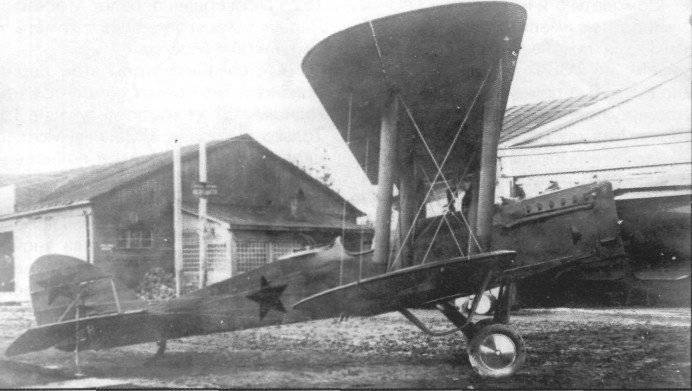
Yes, and the rest of the M-5 produced with the use of imported components. Almost all the aluminum in the country was imported from abroad. "Liberty" was different from all other aircraft engines ignition system of the so-called battery type - like a car. In Russia, its release has not mastered. All M-5 were equipped with electrical equipment imported from the United States, from where the fuel fittings went.
Soviet engines turned out heavier than the "Liberty". For example, M-5 and weighed 424 kg - 29 kg more imported motor.
On serial P-1, domestic engines intended to install 1 with 1925 in October. But the M-5 was not enough for all the machines. For 1925, they were released only 50 units - 20 in Moscow and 30 in Leningrad. Therefore, the import of Liberty from the USA and the UK continued. Engines from England before shipment were sorted out and checked, so they could immediately be put on airplanes. From the United States went a lot of old engines that had lain for several years in warehouses. They were sorted out in Moscow, regulated and tested. This was done by a special workshop on GAZ-1. On the other hand, the improved Liberty of the later series, which had a great resource, also came from America.
In addition, the quality of domestic engines was rated lower than that of imported ones. Thus, when testing the X-NUMX X-NUMX series in Taganrog in November, 1 concluded that "the engines of the Icarus plant are very good at the height." In general, Leningrad engines were initially considered more reliable than Moscow engines. It was M-6B that in April 1926 was put on the planes participating in the flight to Beijing and Tokyo. At M-5 and 1925-5's release, leaks from shirts were recorded, oil was knocked out, and carburetor failures. The M-1925B had about the same thing plus a burnout of pistons, but less often. Moscow engines, on average, worked until the first 26 hours bulkhead, Leningrad ones - 5-50, but met M-55B, which worked more than 60 hours without breakdowns.
FROM SERIES TO SERIES
And then the P-1 was constantly changing, although the changes made to it were not very noticeable in appearance.
On the aircraft appeared synchronizer PUL-9. Its main difference was the drive not from the rear of the engine crankshaft, but from the intermediate inclined shaft, which transmitted the rotation to the distribution rollers. This was due to the fact that “Liberty” of later series began to arrive from the USA, in which the gear of the synchronizer drive was mounted exactly on an inclined shaft. The same decision was made for M-5. In September, the 1926 Sample PUL-9 passed flight tests. The new synchronizer was approved by NK UVVS (RKKVF by this time renamed the Red Army Air Force) 28 October 1926 g. Depending on which engine was put on the aircraft, the type of synchronizer was chosen.
Part of the machines was completed with PUL-6, and part with PUL-9. Completely on the last passed somewhere by the end of 1926.
Until the fall of 1926, an imported Vickers was placed on the left side of all P-1. 3 in May 1926. The city Aviatrest received a letter from the UVVS asking them to try to replace it with the domestic Maxim. On the same plane on which PUL-9 was tested, they tested the Maxim-TOZ modified in Tula. Later, under the leadership of Nadashkevich, the infantry machine gun was converted into air cooling and increased the rate of fire. The new model was adopted later as PW-1. Troops tests of the machine guns were carried out precisely on the P-1 in the 26 squadron in the North Caucasus. With 1928, it began to be put on all aircraft, except for export.
The new machine gun was a bit heavier (about 3 kg), but it paid off with increased firepower. A set of "Vikkers" with PUL-6 weighed 32 kg, PV-1 with PUL-9 - 34 kg.
In the fall of 1926, on the P-1, they tested the English “5-linear” (12,7-mm) machine gun “Vickers” on a Nelson-type machine. He stood on the left side, working with the same synchronizer PUL-9. But the heavy machine gun was too powerful. weapons for P-1: shooting caused deformation of the skin and aircraft side members.
Changed and bomb weapons. In the first half of 1926, new DER-6 (under the fuselage) and DER-7 (under the wing) bombers were put to the test. Together with the SBR-8 dumper, designed by the gunsmith Shcherbakov at the factory in Fili, they had to create a new set of Bombre-2. The introduction of the Bombers-2 according to the plan was supposed with 1 September 1927 g .; so it came about.
In Germany, began to purchase optical bomb sights Hertz FI 110. He allowed to significantly improve the accuracy of the bombing compared with the primitive AP-2. Designers have worked the possibility of installing it on the P-1. In the stowed position, it was fastened with clips to the board, and in the battle position it was placed vertically above the hole in the floor on a special heel. This heel in Moscow began to be mounted from the 10 series, since April 1927. Themselves set the sights already in parts. They were few, since the priority in their delivery was given to heavy aircraft. In 1928, the installation of the “Hertz” on the P-1 was declared mandatory, but the situation has changed little - you can’t put something that is not physically present.
Since 1 in October, 1926 has included a rocket launcher in a complete set of Moscow's P-1, in Taganrog this has happened since December 1.
All these innovations have led to weight gain and deterioration of alignment. In addition, the forced replacement of some semi-finished products by others that were available had an effect. So, tanks were riveted from a sheet 0,8 mm thick instead of 0,7 mm, 6-mm cables were used instead of 5-mm. Domestic stretch ribbons, replacing imported, added to the weight of the aircraft 5,2 kg. The operation of aircraft on uneven airfields forced to strengthen the landing gear - strut, wheels and crutch. In total, this gave more than 11 kg.
In April, 1927 in the Air Force Scientific Research Institute carried out control tests of the P-1 No. 3009 from the 11 series of the GAZ-1. Weighing showed a surplus of kg in 87 compared with acceptance specifications. GAZ-10 cars were about 50 kg lighter, but at the expense of a smaller amount of equipment (on the tested P-1 there was, for example, radio station AK-23) and the use of imported Liberty motors, which were lighter than M-5. However, even on skis, the plane showed a speed greater than the required. But the rate of climb above 2000 m fell seriously.
The centering shift caused a lag when exiting the corkscrew. At maximum load, the car generally became unstable. The chassis, even considering gain, was not strong enough for such a weight. There were complaints about axle deflection; with side winds, it was just dangerous to sit down - the landing gear was falling apart, and the plane was hoisting. But the reason here was not a bad design, but the poor quality of the materials used.
I must say that the reliability of the P-1 in general then wanted a lot better. Due to the poor quality of the metal, stretched ears stretched, hoods cracked. In winter, faced with a cliff rubber cords - ski absorbers.
Petrol pumps operating from windmills (mounted in front of the cockpit visor), drove gasoline from fuselage tanks into consumables located in the center wing section of the upper wing (the so-called “canopy”). The transfer speed depended only on the velocity head. From there, the fuel went into the carburetor by gravity. The excess fuel on the other line had to go back down into the fuselage tank. But with a poorly regulated system, the upper tank was overfilled, and gasoline was forcedly thrown overboard through the drain pipe. Disable the pump or reduce their speed the pilot could not.
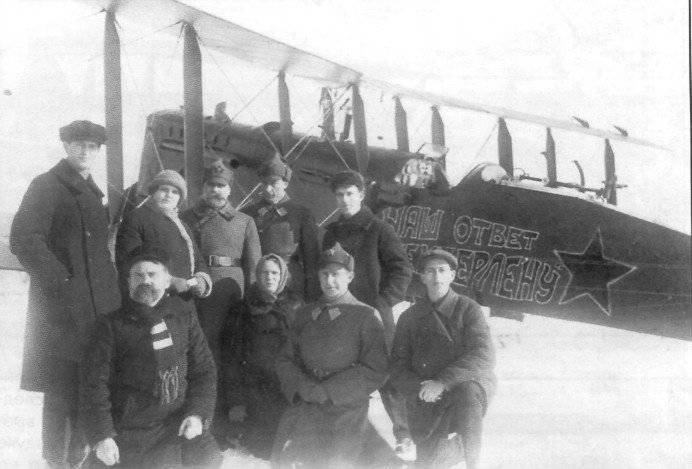
Frequent cases of failure of the pump. Upon termination of their work, the pilot could only count on a small supply of gasoline in the upper tank. This is often the cause of forced landings.
Back in 1924, engineer K.A. Belousov developed a scheme for feeding the engine from the pump to the motor, but then this project was not implemented. In December, X-NUMX on P-1925 No. 1 was the first to test a fuel pump driven by a crankshaft of a motor. In 2741, the experiment was repeated on airplane number 1928, putting a pump of a different type. But they didn’t introduce such a pump on production aircraft, possibly because practically all such pumps were imported from abroad. P-1314 until the very end was produced with chicken pox.
Designers also offered a significant upgrade of the P-1 airframe with the transition from fully wooden to mixed construction. Since November, 1926 in OSS has been developing new wings for a duralumin frame. They were designed in three versions and even made one spar, but they did not install them on the plane and did not let them into the series - aluminum was a deficit, and P-1 built a lot. Another unrealized novelty was the chassis with hydro-pneumatic depreciation, which served as a model for the rack with an English passenger aircraft DH.34, purchased in one copy.
The planes were completed approximately equally with the instruments of Soviet and foreign models, and even on machines of the same series, the kit could have been different. We imported compasses, thermometers of water and oil, speed indicators, ammeters - mainly from England.
The quality of Soviet engines gradually increased. If in 1925, less than a third of the M-5I engines were factory tested without defects, then by 1927, their number reached three-quarters. Of the massive defects were only leaks oil. But the quality of M-5B remained at about the same level. In Leningrad, they were in no hurry to introduce innovations invented by Muscovites. This can be understood: the “Bolshevik” was not an aviation, but an artillery plant; production of aircraft engines there soon began to turn off.
Sometimes engine defects led to very serious consequences. Thus, in the autumn of 1927, during the parade in Leningrad, the motor on the Р-1 56 squadron was scattered in the air over the city. Pilot Purelis with great difficulty managed to land on a wasteland.
STOP? NO - CONTINUE!
Initially, production of the P-1 was intended to cease in the middle of 1928. Its place was to be occupied by the intelligence officer P-4, designed under the direction of A.A. Krylov. The prototype P-4 was completed in May 1926, and then tested and brought to 1928. But the car turned out too heavy, and its centering - too back. In the end, work on the P-4 was stopped, and the military again expressed interest in continuing to build the P-1.
However, time was lost. The Air Force did not sign the P-4 serial production agreement, but did not order new P-1 batches. The deadline for the delivery of the latest P-1 ended with 1 July 1928. The factories could just stop. Having enlisted the verbal consent of the chief of the UHVS, P.I. Baranova, the management of Aviatress has itself concluded contracts with the plants. Both enterprises, the plant number 1 in Moscow and the plant number 31 in Taganrog - as they were called since November 1927, were ready to continue production of cars.
But then the question arose of the need to modernize the aircraft. Finally, 27 on August 1928 of the UNHCR sent a letter to Aviation Trestle with a list of changes that need to be implemented on the P-1 in the second half of 1928 and the beginning of 1929. , new gasoline pump and gasoline pump driven by a motor. The military representative of plant No. 79 added to this the proposal to introduce a reinforced chassis, to provide for the laying of a parachute in the pilot's seat and move the bomb racks forward.
6 October 1928 IM Kostkin suggested first trying out all the new items on the aircraft number 3483, which stood at the plant after repairing the fuselage side member. In order to improve centering on aircraft, the upper wing was carried out on the 300 mm forward, the stabilizer stroke was increased, the bomb racks were pushed forward (DER-6 - by 45 mm, DER-7 - by 223 mm), a tool box with a hatch appeared behind the Letnab's cabin in the upper casing, introduced a control stick and seat belts of the new sample, changed the design of the pedals. The plane was equipped with a radio station and a camera, which brought the empty weight of the car with water poured into the system to 1462 kg. It also made the pilot's seat under a parachute: not round, as before, but rectangular. It was not very successful. When placed in the Irvine parachute cup, the pilot even had a medium eye height above the cockpit canopy. It was not possible to lower the seat further down - the control pedals were clamped in the rear cabin. To their own pedals, the pilot only reached out with his toes.
All these changes were later implemented on serial P-1; that's just the pilot's seat had to be finalized. In addition, they reinforced the frame of the pilot's visor and introduced an outer footboard for getting into the plane. From a wooden chassis with a steel axle, they moved to a stronger, all-metal chassis. But they did not do it for long - only until September 1928, then they returned to the cheaper wooden one.
With 1928, the P-1 was produced in three versions: corps (near) reconnaissance spotters, army (long-range) reconnaissance aircraft and 3 class bomber. The first one included the availability of AK-23 radio station or a special aviation WHO III (weighing 48,3 kg) and two Lewis; bomb rack could be removed partially or completely. The second one was different from the previous one by the presence of the camera Potte I. The third one was carried by Lewis, he did not have a camera and a radio station.
On the 1928 aircraft, the TOZ turret was replaced with a new Tour-4, which had a device that made it easier to rotate the installation at large angles. It was possible to put one machine gun, you can - two on an extra fork. At TOZ bent gear racks, with which the lifting of trunks was carried out. In Tour-4 they were strengthened, as well as some other details. Therefore, the Tour-4 was a bit heavier than TOZ. The Tour-4 kit with two Lewis and 10 disks weighed 63, 8 kg, and the old turret in the same configuration - 56,5 kg. The novelty was approved by the troops. The chief of staff of the 20 air raid Lavinovsky reported to the headquarters of the Ukrainian Military District: “The turret of the“ TUR-4 ”compared to the turret of“ TOZ ”incomparably has an advantage”.
Since 1929, the production of P-1 still began to turn off. Plant No.1 was preparing to switch to the assembly of new reconnaissance systems P-5 of the same NN design Polikarpov. The last aircraft there were assembled at the beginning of 1930. In Taganrog, the P-1 release remained at about the same level for another two years.
The changes made to P-1 during this period were relatively small. The cockpit visor was again increased, and from the aircraft No. 3483 they again switched from celluloid to triplex. On the port side in both cabins made bags for revolvers. Devices were now only Soviet. Optical riflescopes OP-1 (“Aldis”) and redundant annular gearboxes-5, rear-view mirrors and new radio stations of ERO were installed on parts of the machines.
From the middle of 1929, only domestic M-1 engines were installed on the P-5. The import of the Liberty did not stop, but they were now being redesigned for use on tanks... In March 1929, pistons were burned out at the M-5 plant number 24. The reason was considered that the piston crown of the Soviet engine was thinner than that of the original Liberty. After that, we began to produce pistons with a thicker bottom.
With 1930, the aircraft was produced only in two versions: a near reconnaissance spotter and a training aircraft. Functions of the light bomber and army reconnaissance were now assigned to the P-5.
In 1931, the Taganrog plant was also loaded with the development of new types of aircraft. Instead of 302, P-1, according to the plan, turned over the entire 266. The following year, they released the last two cars and stopped the P-1 assembly.
"LORREN-DIETRICH"
Hearing this name, you immediately recall the unforgettable "Antelope-Gnu" Adam Kozlevich. But the French company "Lorrain-Dietrich" produced not only cars, but also aircraft engines. Among them was the popular 20-cylinder water-cooled LD 12E 12 HP engine in the middle of the 450-s. It had a W-shaped layout: three rows of four cylinders arranged in a fan.
These motors were purchased in fairly large quantities in France, and in February 1925 was even raised the question of their release under license in Russia.
As mentioned earlier, in 1924, an idea emerged to release part of the P-1 with French engines. The design assignment for the version with LD 12 was given by 5 August 1924 g .; he received the designation RD2 or R-1LD.
The first estimates of the designers were disappointing. Almost all the flight data for the calculations turned out worse than with the "Liberty". The ceiling fell to 300 m, the flight duration was reduced by half an hour, the rate of climb deteriorated. Only the maximum speed due to the greater maximum engine power should increase by about 5%.
Despite this, the P-1LD continued to attach such great importance that it was laid down in the mass production plan. GAZ-10 was supposed to assemble these planes in Taganrog, according to the draft plan for 1925 / 1926, half of the vehicles assembled by this enterprise had to go with Lorrans.
The designers worked on linking the airframe and the engine. Pairing the engine, which had a large midsection, with a narrow fuselage P-1 was a difficult task. To get around the carburetor located behind, the engine mount struts were curved. This immediately reduced its rigidity and forced them to prop up the pipes in the middle in the middle with pyramids from tubes of smaller diameter. As a result, access to the carburetor was significantly hampered. The engine hood has acquired a more complex shape and design.
On the P-1 there was a car front type radiator. The long toe of the crankshaft passed through the hole in the radiator. The available LD 12E shaft toe was too short; on the "Icarus" for him made nozzles.
In October, 1924 began building a prototype P-1LD; 17 completed it in February next year. February 24 tried to launch Lorraine on the plane. The attempt ended in failure; It turned out that they mixed up the thrust to the carburetor.
6 March 1925. The prototype with the Lorraine was taken to the Central Airfield. We intended to start the factory tests from 10 March, in fact, they were started on March 19. Four days later, the car was handed over to the PLA.
The radiator on the test shook. He secured the strut. Again, bad - too stiff suspension led to the destruction of adhesions by vibration and water leaks.
The weight of the empty aircraft with the Lorraine was almost 100 kg more than the serial P-1 with Liberty, take-off weight rose by about 30 kg. Coupled with poor aerodynamics, this had a negative effect on flight data. They were even lower than estimated. The aircraft lost more than 10 km / h of maximum speed and approximately 1000 m practical ceiling. Significantly dropped rate of climb.
4 June 1925 The prototype P-1 with Lorraine was examined by the Aviatress Commission headed by Akashev. The commission concluded that Lorraine is not suitable for P-1. Work on the P-1LD stopped.
P-2, HE SAME P-1SP
The English DH.9 aircraft was equipped with a Sidley “Puma” motor with an 230 horsepower. It was an in-line water cooling engine.
We have actually started work on the Puma version even earlier than on the plane with Liberty. At the end of the 1922, the VVS handed over a GAZ-1 one DH.9. The factory began to make drawings and even templates, but a little later, the military suspended work, giving preference to the aircraft with "Liberty".
The Soviet representatives succeeded in ordering the Puma 1924 engines in the UK in 150. Under the contract, the British had to deliver the first 30 motors in July, 1925, and then within three months to send by 40 “Pumas”. Since aircraft manufacturers constantly lacked motors, they decided to equip part of the “Russian hevilands” with “Pumas”. Another 1 of April 1924. Plant No. 1 received a task to adapt the aircraft for this engine. At first it was about copying DH.9, then the factory designers suggested using the DH.9a airframe (differing in wing size and fuselage shape), and, finally, used as a base for the P-1 operating time.
The project, named at the 2US1 factory, was carried out quite rapidly. Supervised the work of V.P. Moiseenko. The car had a different engine mount, another hood and a radiator placed under the nose of the fuselage. Already 23 April NK approved a preliminary draft, and 1 April began the construction of a prototype. On August 1 the plane was ready, and on October 1 it was already taken to the airfield. Factory tests of the aircraft, called P-2 or P-1SP, ended by the middle of the same month, and on October 15 the car was handed over to the PLA.
The serial empty P-2 was more than 100 kg lighter than the P-1. The take-off weight was less than the 400 kg. This allowed the use of smaller wheels - 750x125 mm. The strength of the airframe at the same time was assessed as excessive. But low-power motor did not allow to obtain high flight data. The speed, compared with the P-1, fell by 30-35 km / h and was equal to 167 km / h, the ceiling decreased by about 800 m; rate of climb also deteriorated. Approximately the same was assumed according to the calculations of the designers. But from the point of view of piloting the car has become easier; rebalancing made her more stable.
The tests were completed 9 December 1924 g. In general, the aircraft recognized as successful. But the report on the test results moved by instances for a long time. When the factory already had the first production aircraft, it was not yet known what changes the UVVS would require from them compared to the prototype.
The first four serial P-1SP, while without armament, arrived at the Central Airfield in January 1925. One plane was tested in full, the rest were reduced. The cars flew with three types of screws: one English from Davis and two domestic Dyachkov designs from GAZ-8. One of the diach screws was the best. With him got the speed 171 km / h, with the English - 166 km / h.
By the beginning of January 1925, the wooden parts of the first two series were ready, but there were not enough motors and screws. Such speed was explained by the fact that knots of P-1 standing without motors went into operation. All free areas at the plant were occupied by finished products. On January 10, GAZ-1 decided to disassemble the wing boxes on the 15 Р-2 and suspend the assembly of the 30 machines, which had to be completed at the end of the month. The plant filed claims by the UHVS, which under the contract was obliged to supply engines and propellers, demanding to pay for the forced disassembly of the finished aircraft.
Only 19 January military acceptance at the company received a list of additional requirements for the machine. Provided for the shift forward wind visor, a slight movement of the gas sector and the stabilizer control steering wheel, the installation of the backs of both seats. The plant responded that it could do all this only from the 41 aircraft (after all, the reserve for the previous ones is already ready) and for the extra money - you had to think before!
And even less in a month the production was completely paralyzed. On 12 February, 1925 in the shops were 40 ready biplanes without engines and screws, another 90 were in different stages of production. The most interesting thing is that in the UVVF they knew very well that before June the motors from England would not come!
The first “Pumas” really arrived in early June 1925 g. - 15 pieces. All the others delivered by the end of October.
The delay in the arrival of the engines greatly influenced the delivery of the aircraft. By October 1 1925 GAZ-1 was supposed to pass the 52 Р-2, but in reality, only nine finished cars were presented to November 28. They put the PUL-7 and bomb racks, but there were no dumpers.
On serial P-2, on the left side, a fixed Vickers machine gun was installed, and a TOZ turret with one Lewis in the Letnab cabin. Under the "Puma" specially designed synchronizer PUL-7. He passed ground tests 21-23 September 1925. In November, he was officially put into service; by this time he was already in mass production. Released 62 PUL-7; this means that almost half of the P-1 joint venture was delivered with or without full armament.
On the P-1SP, only the ventral bomb-holders DER-4 were installed. On the part of the machines, the plant also mounted DER-3bis, but already 19 in December 1925, when the planes were still in the workshops, they were ordered to be removed.
P-1SP was built in three series - 40, 50 and 40 machines. Of these, 86 passed to the middle of 1926 and 44 in the second half of the year.
WITH BMW IV MOTOR
In 1926, the Puma motor stocks came to an end. But the need for a cheaper version of the P-1 for educational purposes has not disappeared. The English engine decided to replace the German BMW IV, also with in-line water cooling, but a bit less power - the 190 HP. The project of alteration for another motor was developed by E.К. Stoman. Since the BMW IV was shorter, the overall length of the fuselage decreased by 49 mm, the center of gravity shifted slightly forward. They used the propeller from the U-20 aircraft with a diameter of 2,9 m. By order, it was necessary to mount a machine gun and one Lewis on the turret, but the centering of the machine made this impossible.
The prototype was not built. At the factory in Taganrog, a series of 30 copies was laid at once. In June, the 1928 was assembled there the head machine, which was tested at the factory airfield. The whole lot was handed over to customers by the end of the year. Total manufactured 83 aircraft of this type.
MOSCOW - BEIJING AND FURTHER ...
In 1925, the Р-1 and Р-1SP aircraft took part in the Eastern flight on the route Moscow - Urga (Ulan Bator) - Beijing - Tokyo.
For the flight prepared a batch of four specially equipped P-1 with M-5B engines and without weapons. They were distinguished by an additional tank on 7 pounds (112 kg) of gasoline installed in front of the pilot's dashboard, the soft back of the pilot’s seat and the engines that went through an additional bulkhead (in the mandatory presence of the pilots!). These aircraft also put reinforced axle chassis, added additional braces rear chassis struts; it was impossible to place them on combat vehicles - they interfered with the bomb racks. Strengthened crutches, mounted additional manual benzopompy, second batteries. They increased the floor area of the observer and made a luggage box behind his place. Screws put improved, with the leading edge bezel.
In addition to this, in an improved design, two P-1SPs were manufactured, with an elliptical frontal radiator and a coc on the screw hub. Interestingly, the observer's seat on them was performed without a back.
Three of the six cars actually took part in the flight - two P-1 and one P-1SP. Three others, as a spare, were sent by train to Novosibirsk and Irkutsk.
10 June six aircraft selected for the flight took off from Moscow. Among them were two P-1, which were piloted by MM Gromov and M.A. Volkovova (mechanics, respectively, EV Rodzevich and VP Kuznetsov), and P-1SP, on which A.N. Ekatov and F.M. Malikov. Then the group gradually overcame the sections of the route. Because of the low-speed P-1SP constantly flew half an hour earlier than other aircraft.
On July 13, four cars arrived in Beijing; both the P-1 and P-1SP were among them. In August, two spare M-5 engines were delivered to Beijing, after which two P-1 engines through Korea continued on their way to Japan. Over the strait the planes landed in the fog and dispersed. Gromov managed to land in Hiroshima and the next day, September 2, ended up in Tokyo. Volkovova sat on a small island near Shimonoseki, from where he could not take off. This is the end of the Great Eastern Flight of 1925.
In 1926, one P-1 with a pilot, J.N. Moiseev made a flight to Tehran, another, operated by P.Kh. Mezheraup - to Ankara.
ON FLOATS
The design of the float variant P-1, Mr-L1, began at OSS at the end of 1925 on its own initiative. Only in April of the following year did the Air Force sign an agreement with Aviatrest for the design and construction of three prototypes. The military assigned the float machine designation MP-1.
Project MR-L1, prepared under the guidance of N.N. Polikarpov, envisaged the installation of the aircraft on two wooden floats connected to the wings and the fuselage by a steel pipe truss. In August, the project was sent to 1926 for consideration by the management of Aviatress, then it was studied by representatives of the STC of the UHVS, who in October approved it.
Without waiting for the end of this long process, the plant began to build the first car. It was completed in the middle of October 1926. The first flight of the prototype 3017 took place on 19 in October 1926 on the Moscow River at Fili; the car was piloted by VN Filippov. Aviatrestu reported that the hydroplane "proved to be a very good side"; We got the speed of 186 km / h and the ceiling 4200 m. Later we built another instance, No. 3020, with a reinforced chassis. MM flew him in early November. Gromov.
In parallel, a version of the machine with metal floats was created. The task for it was received in March by 1926, the design bureau GAZ-5. There, the contract engineer, German engineer Münzel, was involved in designing the float plane. The total displacement of metal floats was a little more, and the weight of the chassis as a whole - less. The project was ready in October of the same year, but on March 3, 1927 sent the task to OSS. There, the Müntzel project was studied and considered imperfect. Metal floats criticized MM Shishmarev. In his opinion, the volume was insufficient, the contours did not provide proper seaworthiness, the chassis as a whole was unstable to lateral impact, and depreciation was too rigid. The design was calculated for strength again, and some places have increased. 6 May Aviatrest ordered to make chassis components and conduct statistical tests. At the end of June, the nodes were ready, and in August, TsAGI conducted tests.
In early September, the aircraft was installed on the metal floats № 3030. It was distinguished by reinforced spars of the upper wing and increased vertical tailing by 20% (to improve track stability). An unnecessary crutch was removed from the machine, a device for crane lifting and mooring rings were installed. The ventral bomb racks were pushed back, the underwing - shifted to the ends of the wing, placed under the racks. The first flight on the floats of Müntzel took place on September 12 1927, the pilot was Ya.N. Moses. 15 September this car was given to the Air Force Institute. Until October 25 she made several flights, then the tests had to be interrupted due to the need to replace the engine.
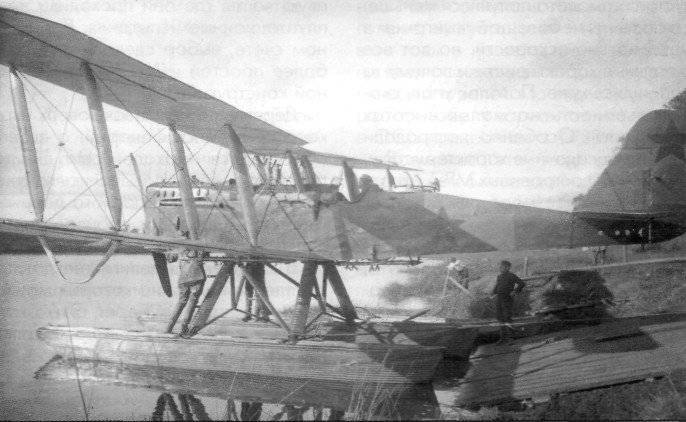
Since the metal floats were lighter, respectively, and the weight of the empty aircraft turned out less. From here - a small gain in maximum speed, but for some reason all other characteristics turned out to be worse. The ceiling fell, the rate of climb at low altitude deteriorated. Particularly affected takeoff and landing characteristics.
All three built MP-1 sent to the Black Sea for further testing. The first car on wooden floats left the factory in Sevastopol 14 February 1927, the second - 10 March. The tests of the first MP-1 ended in December with an accident when landing on a wave of 1,5 m height. The cause of the accident is described in the documents as “landing with a splash”. From the impact of the plane on the water, the rear part of the fuselage and the engine broke off, and the central part with the crew cabins remained standing on the floats. The pilot and Polikarpov, who was in the back cabin, rushed into the water and swam to the shore.
The second plane on the wooden floats, and later the car on the floats of Müntzel, was transferred to the front part, where they passed operational tests. Ultimately, the choice was made in favor of a simpler and cheaper wooden structure.
A wooden float on top of the frame was sheathed with plywood, and then pasted over with a percale. On the bottom, thin teak or mahogany boards lay on top of the plywood. On top of the floats stuffed longitudinal slats, which went.
In the floats there were nests for fastening the wheels on which the car was rolled to the shore. These were the regular P-1 wheels, which were only a third filled with water to make it easier to sink them into place when installed.
The possibility of removing floats from the MP-1 and installing the aircraft on a wheeled or ski landing gear was envisaged. In this case, the machine could fly from land, as usual P-1, but with some restrictions on the load caused by differences in alignment.
The engine was launched on the MP-1 by a manual mechanical starter. A mechanic stood on a float and twisted a removable handle.
The “exemplary” (head serial) MP-1 was assembled at the GAZ-10 plant in Taganrog at the end of September 1927. An additional radiator was installed under the front part of the fuselage, originally developed for the P-4. The area of the vertical tail has increased, the underwing arches have been removed, replacing with rings for mooring. Taganrog floats turned out lighter than Moscow: 195 kg vs. 210 kg. "Vickers" on the plane was missing. The first flight took place on October 12. According to the report, "the overall performance of the seaplane and floats is satisfactory." But it was determined that due to a poor fit, one float is 10 mm higher than the other.
During the tests, it turned out that the head machine data roughly correspond to the prototype built in Moscow. The speed was the same, the rate of climb improved slightly, but the ceiling decreased to 3680 m.
The head of the Black Sea Air Force, Bergstrom, who tried this plane, wrote: “The MP-1 is a cultural plane ... it is lightly piloted in the air, much better than the Savoy, the pilot is sensitive, and the taxiing is heavy.” Indeed, the behavior of the MP-1 on the water left much to be desired. With a wind of more than 6 m / s and a wave of 0,5 - 0,6, the plane was poorly controlled on the water. Wooden screw on taxiing soaked from spray. Metal parts quickly rusted. Already during the wave in 0,5-0,7, the landing was accompanied by “leopards” (jumps) up to 3 m. The floats were gradually filled with water through poorly fitted mouth doors. It turned out that the aircraft was not seaworthy and more suitable for rivers and lakes. But there it was not always possible to find the direct distance in 0,8 - 1,3 km, necessary for the take-off of the MP-1.
The general conclusion of the tests was as follows: "The operation of the MP1-М5 aircraft is possible only in the conditions of a river aerodrome with a well-trained crew."
Approximately the same results were obtained during the trial operation of the first serial MP-1 in the 53 th JSC, the 60 th UAE and the School of Naval Pilots. The most favorable review was sent from 53-th oao, and the most negative - from the school; they considered that in piloting the MP-1 is too strict and is not suitable for training young pilots.
As a result, the UVVS concluded: “The plane MR-1 should be considered a palliative and its operation is temporary ...”.
However, the mass production of the MP-1 continued. The series of float machines were part of the total number of plant number 31, so the first one was called 16, followed by the 17 series of regular Р-1 on wheels and then two series of hydroplanes - 18-I and 19-I. The series included on 10 hydroplanes.
The 18-series machines had the lower wings of the land version, in which only one span between the ribs was sheathed at the plywood - at the fuselage. The rigidity of such a biplane hydroplane box was insufficient. Pilot Remezyuk wrote in the test report of one of the machines of the 18 series: “The wings shook unnaturally, and the center-section braces dangled like ropes.” Then it was worse. The report concludes: "... the identified deformations of the aircraft after 10 flights are so serious that they make the aircraft dangerous for flights." Wings had to be strengthened.
This was done on 19-series airplanes, which surrendered to 1928 in December. On these machines, the shoes of the center-section attachment pads were reinforced and they began to cover with plywood two flights of the lower wing on each side. In addition, they introduced a solid putty for the plywood skin of the fuselage (previously only screws were putty), varnished all aluminum parts, introduced a new pilot strap and a mechanical inertial starter with a removable crank. The deck of the float was now trimmed not overlap, but end-to-end with overlapping joints with copper tape. Bomb armament was made up of Der-7 bomb racks under the wing and SBR-8. On the plane there was one machine gun, the PW-1 and two Lewis, and the latter took the 10 disks. All this weighed down the car on 20 kg, the weight of the empty aircraft was 1955 kg.
However, even further with the strengthening of the wings, the box on the MP-1 had to be re-adjusted much more often than on wheeled vehicles.
Production of the MP-1 in Taganrog led to the end of 1929, releasing a total of 124 copies.
STORMERS
In 20, the concept of an “action movie” was actively developed - a specialized attack aircraft for action at the front and in the rear, designed to destroy enemy manpower with powerful machine-gun fire. A similar unarmored car was going to be made on the basis of the P-1. The plan for 1926 / 27 provided for the creation of a “fixed battery pack” for it. Later they went further - it was proposed to create a mobile fire installation, controlled by Letnab.
At the beginning of 1927, OSS began to design a simpler, fixed version. On each side, under the lower wings, it was necessary to place one “Maxim A2” or “Maxim T3” machine gun. To compensate for the weight of installations, the number of underwing bomb racks was halved. Cartridges for machine guns on the wing decided to place in the drums. But in order to put the tape with the required UVVS stock in 500 cartridges, a drum with a diameter of at least 450 mm was needed. Such "barrels" significantly worsened the aerodynamics of the aircraft. Guide OSS turned to the UHVS for permission to limit the 250 ammunition cartridges on the machine gun. This would allow the drums to be pressed down to an acceptable diameter of 225 mm.
The movable version also provided for the installation of two additional machine guns, but with the possibility of deviation up and down on 15 °, right and left on 45 °. To control the movement of trunks should letnab. What was going to turn machine gun installations - is unknown; In those years, there were neither electromechanical nor hydraulic turrets in our country. Apparently, the development of both variants of the “action movie” in the OSS was stopped in 1928.
Perhaps this was due to the emergence of a more successful design. In 1928, in the 5-th aviation unit in Kiev, they fixedly mounted on the lower wings of the P-1 one machine gun on each side. Cartridge tapes were placed in boxes inside the wing. New weapons tested, including shooting at the site. In 1929, on the part of the brigade airplanes, in a similar way, additional MF-1 were installed; the weight of machine gun installations forced to reduce the bomb load for these machines.
Another effective method of defeating infantry and cavalry was the use of a large number of small fragmentation bombs. But their suspension on the P-1 was limited by the number of locks on the beams of the bomb racks; when switching to small-caliber ammunition, the actual bomb load decreased sharply, the aircraft could not fully use its carrying capacity. In 1926, on GAZ-1, they developed DER-10 cassettes designed for 2-kg bombs. But on the serial P-1 they were not installed.
For a long time, there was the practice of completing flight schools with obsolete and worn-out combat aircraft. When the production of P-1 was established, they began to send DH.9a that became unnecessary. After a short operation in combat units, all P-1SPs were transferred to schools.
Later they were joined by worn out P-1 of the first series, which were already considered unsuitable as combat ones. The further, the more such cars entered flight schools and other educational institutions. A considerable part of armaments and equipment was already removed from them, sometimes they reinforced the chassis.
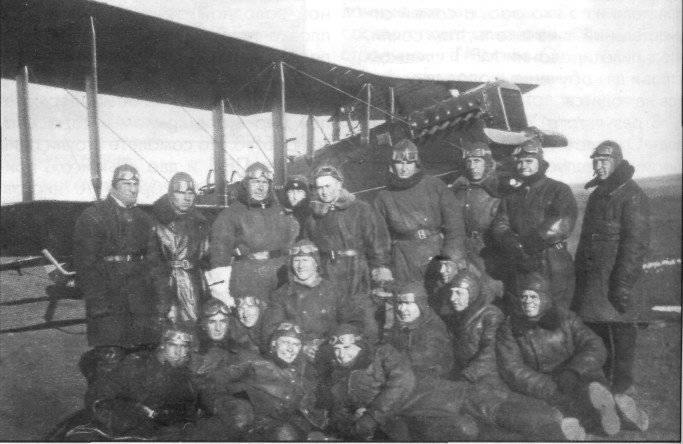
From 1928, the plants produced the P-1 version specifically for training purposes. So, in February of that year, GAZ-1 made six cars without bomb armament and with additional chassis braces for the Air Force Academy. They never put twin machine guns on turrets and ventral bomb racks on training machines; radio stations and cameras met only on the machines of schools that trained observer pilots.
Strike force of the Red Army Air Force
P-1 began to arrive in the Air Force combat units in 1923. Their combat value was very low. Aircraft of the first series could only conduct visual reconnaissance. It was effective only from low altitudes. From a height of 1000 and more, observers found it difficult to determine what they see below. Tangled wagons with artillery, it was impossible to determine which equipment was moving at all. Bombing due to the lack of bomb racks and snubbers was conditionally designated as a missile launch. In some squadrons and detachments, hand-made bomb holders and throwers were made, and cameras were mounted.
Airplanes with more or less full-fledged weapons began to arrive from the plants by the end of 1925. Thus, under Leningrad, the P-1 with the Bombre-1 kit arrived only in the middle of July, 1926. in military units. Often in the same squadron there were P-1 with different weapons and equipment, not to mention the devices. At the same time, parts often changed the equipment package and their location on the dashboard.
At first, there were many complaints about the low reliability and operational inconvenience of aircraft armament. The units received complaints about excessive efforts on the arms of the bombers, the tight movement of the turrets.
P-1 gradually squeezed out the Sopvichi and Arieits from the Civil War, the later Italian Ansaldo and SVA, the English DH.4 and DH.9 left over from the civil war. Already in January, 1926, the “Half Head”, “Arieits” and DH.4, were officially removed from service.
P-2 (P-1SP), given the general shortage of aircraft in the Air Force, initially tried to use as combat. For example, they were received by two separate detachments and one squadron in the Leningrad Military District. So, in September 1926. The 28 Squadron on the P-2 participated in the 4 Cavalry Division maneuvers. She conducted reconnaissance, photographed and tried to correct artillery fire with the help of AK-23 radio stations. The latter failed badly - AK-23 was too unreliable.
The P-1SP lasted about a year in the front-line units - until the spring of 1927; then all of them were gradually sent to flight schools. Thus, in the Leningrad district in the 1 corps detachment on 1 in January 1927, all the Р-1 joint ventures are listed as spare; The 41 Squad was fully rearmed by the end of the spring.
In general, by the autumn of 1926, the P-1 had already spread almost throughout the entire country and became not only the most popular scout, but in general the most widespread aircraft of the Red Army air force. These machines are constantly involved in various maneuvers.
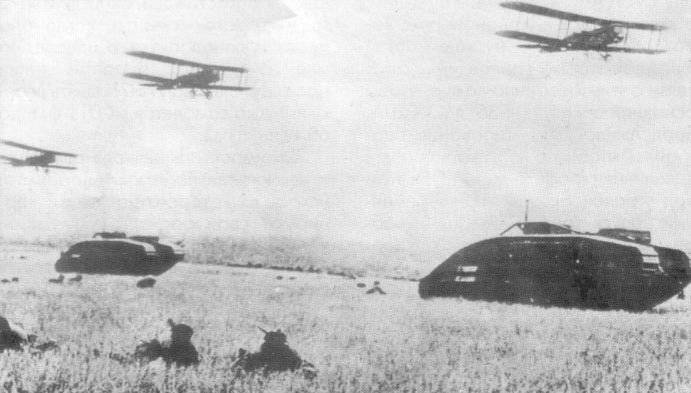
For example, 15 in November 1926. Aviation participated in joint exercises with anti-aircraft artillery in the Kachi area. Returning to the place of permanent deployment in Kharkov, the P-1 group from the 24 squadron got into an emergency situation. At the Pavlograd-Lozovaya stage, one of the planes broke out in the air. Pilot V.V. Bubnov managed to make an emergency landing in a meadow near Domaha farm, but because of the smoke on the run, the car buried in a haystack. The stack caught fire, the flame from it was transferred to the sheds located nearby. Peasants rushed to extinguish the flames, but the pilots did not let them to the stack, fearing the explosion of the rest of the gasoline in the tanks of the aircraft. Militia arrived at the scene and arrested the crew. P-1 completely burned out. Investigation showed that the gas line was the cause of the accident: both mechanics who were preparing the car for departure were drunk ...
By the autumn of 1927, the P-1 park had reached a significant amount for that time. On October 1 there was a 724 P-1 plus 116 P-1SP. The arrival of new technology allowed us to begin to write off the first series of the P-1. So, all the aircraft production 1923 g. Written off in 1928 g.
Crews learned to conduct visual and photographic exploration. Letnab wrote the reports with a pencil on sheets from a notebook, put them in a pencil case and dropped them with a pennant somewhere close to the command post. Messages from the ground, tied to a rope between two poles, were lifted by a “cat” - a hook on a cable. Short phrases could also be transmitted by code with the help of Popham panels - wide strips of white fabric that fit on the ground in various ways.
Bombing was carried out singly and by the bomb dropping systems. Lined up in a column or bearing. They used mainly bombs for 8, 10, 16 and 32 kg, but with 1928, new AF-82 bombs were used. After dropping bombs, it was supposed to make several visits to the enemy's firing from machine guns.
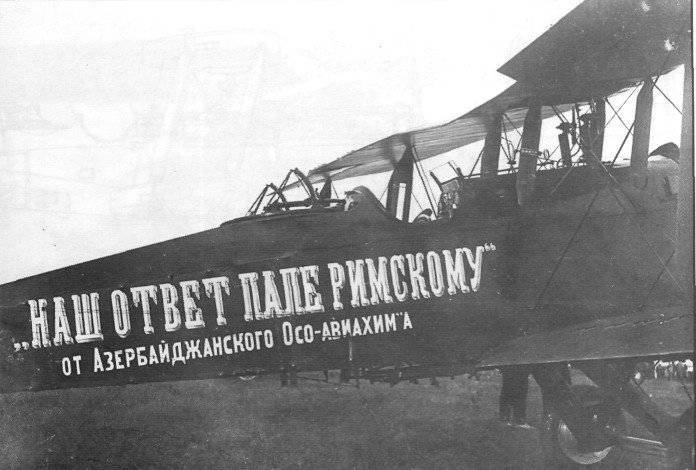
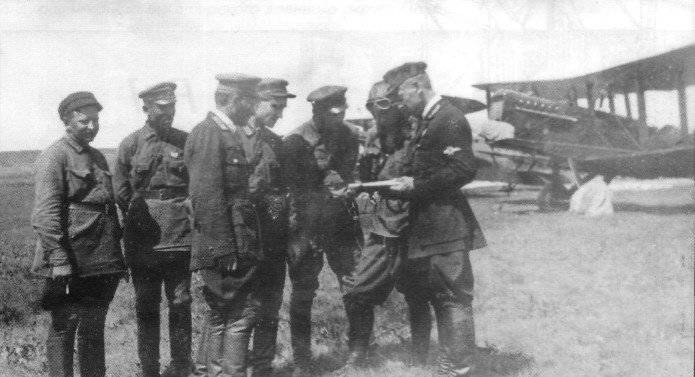
Here is a typical assignment for the crew of the P-1 at the exercises (July 1928, 25 Squad, Chita): reconnaissance of the location of the 75 th reg. reports "cat".
Major maneuvers of the Red Army were held in Ukraine and Belarus in August 1928. During these exercises, a group of five Р-1 28 squadrons, led by detachment commander Sergeyev, flew to “bomb” the Bakhmach station. At first, the pilots got lost, and instead of Bakhmach they tried to attack Konotop, but then letnab lead realized a mistake. The group turned around and after a while safely passed over the target, firing flares. But on the way back the squad commander began to stray again. One P-1 broke away from the group and went off on its own, but correctly flew to the base. The rest are less fortunate. Two cars made a forced landing: one was successful, and the second was squatted. The commander with one slave accidentally went to the airfield in Gomel, when it was already dark. Sergeyev immediately went to the landing, missed and landed on a wetland. The second pilot waited a long time until the landing lights were lit, he burned all the gasoline and crashed into the hangar as he landed. In general, the accident rate on these exercises was very large. Only the forces drawn from the Leningrad district lost four P-1 and seven more were repaired.
Usually P-1 flew only during the day, but on August 28 1928, on maneuvers near Gomel, two P-1 16 squadrons were released for night reconnaissance. They should have sat down in Gomel, where a searchlight was placed at the airfield. One plane landed safely, another long rolled right on the searchlight, then abruptly turned aside and crashed into the hangar.
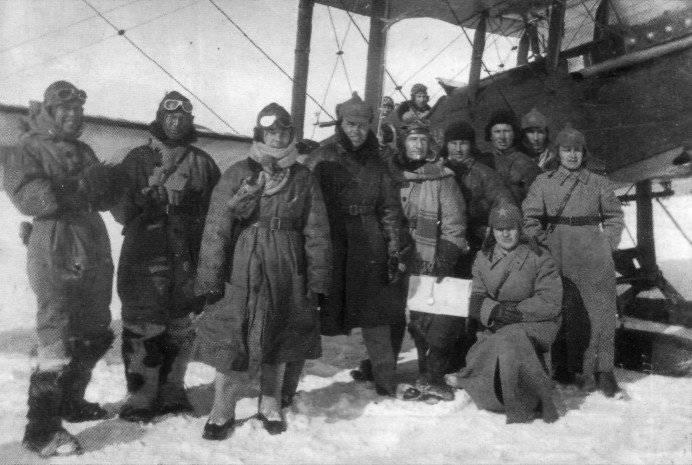
By the end of autumn 1928, the number of P-1 and its variants in the Air Force reached a thousand. The imported DH.9 and DH.9a, as well as their Russian-made counterparts, were written off completely. Back in March, the UHVS ordered that these machines "... are subject to mandatory and immediate removal from operation."
Motors M-5, like Liberty, on the P-1 constantly suffered from overheating in the summer. To combat this temporarily removed the side panels of the hood. But it did not help much. In the Caucasus, they tried to install an additional radiator from the MP-1 on the aircraft. But its effectiveness was not great - it was partially obscured by the hood. In Central Asia, radiators from the P-1SP were used, placed at the rear chassis struts. Radiators were taken from warehouses, and a kit of parts for their attachment and connection to the cooling system was supplied by the Moscow factory number 39.
Since 1927, a lot of attention has been paid to air navigation. For training crews made long-distance flights. 19 June 1927 was organized "star flight". From different cities the planes flew to Moscow. Total then participated 10 machines. The scales were constantly growing, whole military units began to make flights. So, in June 1929, the 26 Squadron, in two groups made a flight Rostov - Kharkov - Smolensk - Krasnogvardeisk. 15 machines from 16 safely reached the destination.
In September of the same year, a large number of P-1 were attracted to large-scale exercises in Belarus. They worked for both the “red” and “blue”. At these exercises, the first time they filmed an airplane: September, 16, the cameraman filmed the approach of the “blue” units to Bobruisk.
MP-1 from 1928 were in service on the Black Sea (in 55 and 65 units) and the Baltic (in 51, 66 units, 87 units). They were used mainly for reconnaissance off the coast. In naval aviation, the MR-1 enjoyed a low reputation. They were considered quite difficult to pilot and non-seaworthy. Even a little excitement made the take-off and landing very dangerous. But even with calm water, a long run-up sometimes led to trouble. The plane went beyond the safe zone and ran into obstacles. There were cases of collisions with small vessels or buoys. In the 1929 on the Black Sea, the MP-1 took the first place in the accident rate - 14 cases.
These machines also completed river units attached to military fleets. In the Dnieper flotilla, the MP-1 was armed with the 67-th detachment, in the Amurskaya - 68-th detachment.
2 August 1930. Three Р-1 participated in the landing of the world's first airborne assault force at the Klochkovo farm near Voronezh. Paratroopers were thrown from a Goliath bomber, and single-engine biplanes delivered packages of weapons and ammunition, also dropped with parachutes.
The peak number of P-1 and its variants in the Air Force was reached at the beginning of 1931. On January 1, there were 1517 Р-1, 20 Р-1SP, 79 Р-1БМВ and 71 MR-1.
27 March 1931. Two Р-1 from 28 squadron sent to photograph the buildings of the Karelian fortified area in order to check the state of their disguise. But the young pilots got lost and removed the fortifications on the Finnish side of the border, near the Viisijoki River. The flight did not go unnoticed: the Finnish Ministry of Foreign Affairs sent a note of protest. And only then it turned out that our crews took pictures. The command of the Air Force of the Leningrad region for a long time decided what to do: whether to punish for a mistake, or reward for valuable information. In the end, they took the “Solomon's decision” - not to do either of these.
By the time the car is already out of production; it was replaced by a new biplane Р-5. First of all they re-armed the light bomber squadrons, then the long-range reconnaissance squadrons. P-1 turned out to be pushed into military aviation and flight schools.
Already in January, 1 932 in the combat units remained only 17 MP-1, the rest were transferred to the School of Naval Pilots. They were replaced by C-62B flying boats purchased in Italy.
The last P-1SPs were written off to the beginning of 1932, but more and more P-1 were transferred to schools. At the beginning of 1933, the P-1 was still 1297, but of these, 705 were located in various flight and technical schools. Most of the rest were part of military aviation — in corps, artillery, and mechanized mechanized detachments. Almost all (61 of 62) P-1 BMWs were concentrated in the School of Naval Pilots.
In June, the 1933 was handed over to the MP-1, the last combat unit - the 67-th River Squad.
In 1935, the Air Force remained only a single machine, used as an auxiliary. So, for the whole Ukrainian military district, four P-1 remained. A year later, they were gone.
IN FIGHTING AND TRIPS
The first military campaign in which P-1 participated was in the North Caucasus. During the years of the Civil War, the Chechens brought a lot of anxiety to both white and red, as they were slaughtered and robbed of both. After the end of the war, it took a lot of effort to defeat numerous gangs. There were entire areas not controlled by the Soviet authorities. The forces of the OGPU could not cope with the situation, and in the spring of 1924, units of the Red Banner Caucasian Army, supported by aviation, were deployed. The 3 th reconnaissance detachment, which included three new P-1 Taganrog assemblies, was transferred to the Grozny region. From September 1925, they began to fly to villages occupied by the rebels.
The planes were supposed to put pressure on the local population, who was demanded to hand over weapons and bandits. They dropped small fragmentation bombs and dropped leaflets. The targets were chosen by the pilots themselves, who were tasked with creating as much noise and panic as possible with minimal disruption. Aviation also conducted reconnaissance and liaised between units of the Red Army.
In April, 1928 for operations against the Basmachs in Central Asia in Tashkent formed a special-purpose group, which included seven P-1. In the middle of the same month, a squadron of 30, also armed with Р-1, was transferred to Tashkent from the Moscow region.
From the beginning of May, these units launched combat missions from the Tashauz airfield in Tajikistan against the gangs of the Junaid Khan group in Karakum. Due to the significant, in comparison with other types of machines, exploited in Central Asia, the bomb load, P-1 used mainly as light bombers.
Р-1 from 9-th squadron, North-Caucasian Military District, Rostov-on-Don, January 1930
30-I squadron tried to use tactics that pilots were trained for the war in Europe. They flew in groups - units and troops, carried out bombing from a dense system. But this could bring success only if there were sufficiently large targets, while the Basmachis quickly learned how to disperse and disguise themselves from aviation.
"Special Purpose" seems to be explained by experiments on the use of chemical weapons. Documents on the activities of the group remained small. Perhaps the materials about her work are still classified. But there is indirect evidence. For example, in one of the emergency actions of the 30 squadron (about a forced landing while following the target - the nomadic camp), it was explicitly said: “neither fragmentation nor chemical bombs exploded”. The county’s report on the summer campaign that year included a section on the effectiveness of the use of chemical weapons in local conditions, clearly written on the basis of past experience.
The experience was negative. Chemical ammunition of small calibers, then available to the Red Army Air Force, was useless to use for small, fast-moving groups of riders. The concentration of toxic substances was so small that it was impossible even to temporarily disable a person or a horse. It was only in human settlements that the enemy could be harmed, but mostly civilians and livestock suffered.
In general, the P-1 manifested itself in Central Asia not in the best way. Great were losses due to accidents; All-metal U-21 and P-3LD lived longer and broke less often. All Р-1 to 1928 was removed from the district.
The third important campaign in which P-1 participated and the only one in which the MR-1 was used was fighting on the CER in the summer and autumn of 1929. All aircraft used there by the Soviet side, with the exception of one squadron, were armed with P-1 (68 machines) and Mr-1 (ten). 8 September 1929, the Special Far Eastern Army (ODVA) troops from Primorye, supported by the 19 squadron from the Grodekovo airfield, launched an offensive west, in the direction of Pogranichnaya station. The Chinese suffered losses and retreated.
October 10 Soviet Amur Flotilla entered the mouth of the river Sungari. The bombing of the 40 Squadron and the fire of the ships destroyed a gunboat, three armed steamers (and only one aircraft) and a barge-floating battery, later captured by our landing force. The landing of troops ashore at Lachasus was supported by the 68 th detachment on the MP-1, based on the Amur floating base. He put down a Chinese battery near the village of Chichikha.
"Cupid" accompanied the flotilla when moving up the river. Its hydroplanes conducted reconnaissance and struck the ships and coastal positions of the Chinese. In particular, 30 of October, they stopped the attempt to block the fairway by flooding barges with a stone. The pilots sank one steamer and a barge, while the others drove up the river. At the same time, the “Kiang-Hin” cannon also suffered significant damage, which later sank on Fugdin’s raid (Fujin). Through the remaining free passage, ships of the Amur flotilla with troops on board went up the river and, with the support of the aircraft, took Fugdin.
From west to east, the Trans-Baikal group of troops struck the CER line; it consisted of one squadron and two squadrons (total 31 P-1), located on the airfield Dauria. On November 17, after an air raid, tanks cut the railroad in the section Manzhouli-Jaylanor. Cavalry began to develop a breakthrough, aviation bombed congestion of the Chinese. In one case, there was an embarrassment: instead of infantry and cavalry, herds of cattle came under the bombs, which were driven along the road by nomadic Mongols. Justifying, the pilots explained that from the height of the sheep are very similar to the infantry in gray overcoats, and the cows and camels - to the cavalry.
Under Jaylanorom, for the first time, the interaction of aviation and motorized infantry took place. Stopping the attempt of the Chinese to escape from the environment, the pilots worked as beaters. They machine-gun fire drove the enemy on a chain of trucks AMO with machine guns, which finally finished off the enemy.
At the same time, the Primorsk group of troops began to attack again from the west; she was going to Mishanfu. Aviation was very efficient at crossings across the Muren river, along which Chinese troops departed. Dense clusters of soldiers represented an excellent target for machine-gun fire, and for small fragmentation bombs. The latter were torn, hitting five to eight people at a time.
The onset of cold weather significantly complicated the work of aviation. Already at 15 degrees of frost, the instruments on the P-1 began to “lie”, air bubbles made the compass needle invisible. With 25 degrees, the clock on the dashboard stopped, the film in the camera stopped rewinding. Earlier, a rubber pear froze, with which letnab lowered the shutter of the camera; for warming it simply thrust into his pants ...
Increased time to prepare aircraft for departure. A group of 12-14 machines took up to two hours. Water and oil were heated in "potters" (Goncharov heaters) or field kitchens.
The planes bombed enemy airfields, warehouses, barracks, railway stations. After the surrender of the garrison at the station of Manchuria, the pilots searched for the fleeing enemy soldiers in the steppe and directed the Red Army men to them.
The entire period of hostilities, Chinese aviation did not show much activity; No air combat was recorded. The enemy had almost no anti-aircraft artillery; Chinese soldiers fought off attacking aircraft only with rifles and machine guns.
The fighting went on until December 6 and ended in complete surrender of the enemy. Soviet aviation lost four P-1 and two MP-1; none of them was shot down by the Chinese. Three Р-1 burned the crews themselves after the forced landings (two of them - by mistake, on their own territory), one crashed during a training flight. Two MP-1 also made a forced landing (and one on the floats - on land!). One of them burned themselves, the second smashed the Lenin monitor, which was taking the crew off the plane, with an armored side.
There were losses among the aircrew, one crew was captured by the Chinese; his fate remained unknown.
Although the P-1 was in service for about five years, they no longer had the opportunity to fight in the ranks of the Red Army air forces.
NOT ONLY ON YOUR EARTH
P-1 quite actively exported to the countries of the East. Export cars were issued as “special purpose” orders. Such planes sometimes differed from the equipment supplied by the Red Army air forces, and sometimes they did not. P-1М5 was offered for export twice cheaper than P-3 with the same motor.
Afghanistan was the first foreign country to receive P-1. In September, 1924 from Tashkent to Kabul across the Hindu Kush ridge overtook six aircraft. The flight commander of the Air Force of the Turkestan District P.Kh. Mezheraup. In March, 1925 sent a group of pilots from the 1 th reconnaissance squadron from Lipetsk to Afghanistan with a new batch of aircraft. The commander of the detachment V.N. commanded her. Zhdanov (later Lieutenant-General, Commander of the 8-th Air Army). The Soviet pilots were tasked with supporting the troops of the Afghan ruler Amanullah Khan during the internecine war. They were listed officers of the Afghan army, wore a local uniform. An aviation school was organized in Kabul, where local cadres of flight and technical personnel were trained. The instructors and instructors in it were Soviet specialists. In 1927, the last batch of seven P-1 arrived in Afghanistan.
Our crews were mainly reconnaissance, but also occasionally bombed and assaulted enemy units. In December, Amanullah Khan's 1928 used air force against the rebels who approached Kabul. From 17 December, the planes began to bomb the enemy. This helped to discard the enemy from the capital, but did not save Amanullah, who soon had to abdicate. Soviet pilots left the country, where they spent more than three years.
15 January 1929. The leader of the rebels, Habibullah, declared himself emir. He got the entire fleet of Afghan aircraft. Now the planes began to bomb and fire at the supporters of the ousted Amanullah. The third challenger, Nadir Shah, who captured Kabul in October 1929, won the fight. He already had the remnants - only a few machines that could rise into the air. It is possible that the last P-1 have lived in Afghanistan for another year or two.
At the end of 1924, the first P-1 put Sun Yat-sen's government army into China. Already in the First Eastern Campaign in February-June 1925 three P-1 participated, providing intelligence and communications. In the second campaign, in October, only one plane was used, but he had already dropped bombs and flyers on the Weizhou fortress.
October 27 1925 g. GAZ-1 received an order for 18 special purpose aircraft. Later it turned out that in fact it consists of three lots of cars. Three aircraft were destined for the flight to Beijing, and the rest - for export, and in two different countries. On November 4, a special commissioner arrived at the plant, delivering a package with requirements for the first export batch. They were instructed to put blue circles with 12-ray white stars on the wings and fuselage. It immediately became clear that the cars would go to China. In addition to foreign markings, export Р-1 received additional radiators necessary for a hot climate. Packaging is also very careful.
Apparently, the planes in the boxes were transported along the Trans-Siberian Railway to Transbaikalia, they were collected near the border and then drove through the air. Not all planes sent to the Chinese safely reached their destination. One P-1 was broken on takeoff in Verkhneudinsk by a pilot Novichkov. When landing in Altan-Bulak, the pilot Pyatnitsky broke the chassis, screw and radiator, but this car was repaired. Two P-1 collided in the air in 100 km from Urga. One pilot was killed, the second and two more crew members were injured.
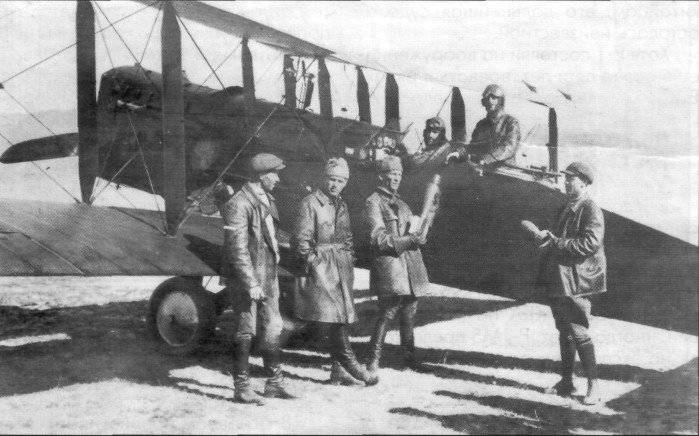
According to various sources, in June 1926 of the People's Revolutionary Army of the Kuomintang located from six to 13 P-1. In the "Northern campaign" in July-November of that year sent three cars with Soviet crews. He commanded this detachment V.L. Melnikov. At first, only one aircraft of the pilot Kravtsov participated in the operations, then the second, pilot Sergeyev, arrived. They bombed and stormed, conducted intelligence. 210 bombs dropped on the fortress of Sheshan. When taking the city of Nanchang, Sergeev’s crew bombed an enemy armored train several times, forcing him to cease fire.
12 April 1927, General Chiang Kai-shek made a coup d'état, after which relations with the Soviet Union deteriorated sharply. The supply of aircraft and other weapons and military equipment from our country stopped. However, the previously transferred machines continued to be used. For example, in April 1928, they participated in operations against General Zhang Zolin's troops. At the same time one P-1 14 April crashed during reconnaissance.
The Soviet Union continued to supply aircraft to some local rulers in northwestern China, in particular, to Xinjiang and at the beginning of the 30s. Cars were distilled through the air. 25 December 1931, during an intermediate landing in Urumqi, at one P-1, the back stretch on the right side broke, but the aircraft was not damaged in general. The entire biplane batch was commissioned on December 23. Total in China put about 30 P-1.
The second part of the “special purpose” batch ordered by GAZ-1 in the fall of 1925 was intended for Persia (Iran). These P-1 had bombers, copied from the English sample and adapters on synchronizers for British machine guns. A look at these 27 machines in November arrived Iranian spokesman Amin-zade. He asked several to alter the control knobs, put the second batteries, provide a manual fuel pump at Letnab and be sure to provide the turrets with forks for twin machine guns. By color, Iranian planes should not be different from the Soviet ones, but under the lower planes it was required to depict a flag with a lion and the letter “P”.
Apparently, the cars were transported by rail to Baku and collected there. In any case, it is known that in January 1926 of Aminzade during a test flight on the Р-1 in Baku suffered an accident during takeoff due to the failure of the Liberty engine. The plane was broken completely, and the pilot got off with bruises.
A year later, the Iranian military ministry negotiated the sale of P-1 intelligence officers, U-1 training aircraft and I-2bis fighters. In June, 1927 Plant No. 1 was given the task to prepare three P-1 with new fancy identification marks and packaging for their transportation by sea. These machines were manufactured and delivered.
In January, 1928 was sent to the Persians by another 10 aircraft. Their configuration was different: half with Liberty engines, half with M-5, TOZ turrets stood only on two machines, on the rest - only Maxim course guns. Delivered this batch through the Caspian Sea. Deliveries continued and further: 15 August 1929 The Iranian representative Isa-Khan Staudah received four more P-1s at plant 1.
Iranian aviation used part of the received aircraft to fight the rebels in different parts of the country.
P-1 was also supplied to Mongolia. In 1929, the Mongols handed over six new aircraft. One of them was soon defeated, and the two were disassembled for parts in order to maintain the combat capability of the rest. On 12 on April 1932, the Mongolian Air Force had three P-1, three P-5 and one Junkers B-33 transport aircraft; they all entered the only squadron in the country to them. Sukhe Bator. By the end of the year, the park was replenished with two Y-2 and four P-1.
In May-July, 1932. Two P-1, along with one P-5, participated in operations against the rebels. Crews were mixed: Russian pilots and Mongolian Letnabs. Aircraft conducted reconnaissance, scattered leaflets and provided communication between parts of the Mongolian army and volunteer detachments. A scout discovered two large gangs near the Kichigin-Gol river, which prepared from different sides to attack the mechanized detachment. The pilots dropped fragmentation bombs, and then with machine gun fire they supported the attack of the motorized infantry.


There were several more cases of bombing, for example, in the monastery where the rebel commanders were located. But their effectiveness was low, since the Mongolian Letnabs did not have enough experience.
The enemy did not cause the aviators big troubles, the “gray damn bird” inspired him with superstitious horror. Only a large gang of Dzhamtso, a former military man, put up serious resistance. P-1 was greeted with rifles from rifles, and Jamtso learned his people to shoot with the necessary lead. Cars returned with holes. On the P-1 pilot Ivanov, a bullet pierced the radiator, had to sit down in the gang's location. The pilots managed to escape, and the plane was burned by bandits. Ran away, however, not far: fell into the hands of another gang. The pilots were robbed, stripped, tied up and thrown into the water. Fortunately, Ivanova was tied badly; he swam out himself, untied and pulled out Letnab. On the eleventh day, naked, hungry people met with Mongolian scouts.
The last P-1 were operated in Mongolia as training aircraft until the middle of the 1930-s.
EXPERIMENTS
What did not do with the P-1. In November, the 1929 design department of the Air Force Scientific Research Institute was tasked to develop an in-flight refueling system for the P-1. Its use would significantly increase the range of the aircraft. Since mid-December, the group of engineer A.K. She started to design the necessary equipment. The draft design was completed by 5 on April 1930. From June 4, production of equipment began in the workshops of the research institutes. By July 7 everything was ready, but I had to wait for the arrival of two serial P-1 for rework.
One plane was converted into a tanker-tanker, the second one was equipped for refueling. On the tanker 30 m hose was wound on a drum mounted on a turret. Rotating the turret, it was possible to release or reel the hose. Machine guns, of course, withdrew. A telephone wire was attached to the hose with a cloth to level the electrical potential between the two machines. This wire had plugs at both ends that were connected to sockets on airplanes. The hose was released outside through a window in the floor intended for the Hertz bomb sight. To make the hose less loose in the air, a weight was attached to its lower end. On both aircraft in the fuselage installed tanks with a capacity of 32 liters, disconnected from the gas system.
At first, the crews of the aircraft trained by releasing and catching the rope with a load. The first flight with refueling made 29 August. First tried to pour water, then gasoline. The distance between the planes was about 12. The mechanic, who was sitting in the back cabin of the filled P-1, caught the weight with his hands and tucked the end of the hose into the tank mouth. After the end of the overflow, he pulled it out, and the automatic valve on the hose blocked the line. They were afraid to retract the hose back - just dropped it before landing. Total until December 1 made 26 flights. It was concluded that the adopted method is dangerous for the aircraft being refueled and its crew. Loose weight could cause serious damage. In one case, she actually pierced the upper plane, and then the hose came under a screw, which cut off a three-meter piece from it.
The experience gained by the Packed group was later used in the development of refueling systems for other aircraft.
For P-1 developed the first landing suspension, special bags and boxes. So, it was on it that the “cardboard air gatherer” was tested - a cigar made of dense cardboard with a parachute container G-2 at one end. Six rifles or zincs were packed into it with 5000 cartridges. An alternative was the cargo bag G-3, also with a parachute. It could put three 76-mm projectile or three light machine guns DP or three boxes with machine-gun belts. An even greater capacity was possessed by a kit based on a cargo parachute of the 3A type. It included several types of cylindrical containers for loads of different types weighing up to 60 kg. In one container could enter four Lewis machine guns or six DP, 64 grenades, seven 76-mm shells. Provided for tanks for water, gasoline and oil. A disassembled dynamo-reactive (recoilless) gun was placed in two cylinders: in one barrel, in the other a lock, a tripod and a sight. The P-1 could carry one bag or box on each side under the bottom wing.
In 1930, it was proposed to convert the P-1 into an ambulance plane. But further general considerations on this subject are not gone.
It was on the P-1 that the first device was tested for laying telephone lines from the air. The plane dropped a field telephone with a parachute and from the height of 100 m began to unwind the wire from the reel; at the end a second apparatus was dropped from the car. 1 January 1931. In this way, they laid a line with a length of 2,5 km.
The famous inventor PI. Grokhovsky at the Scientific Research Institute of the Air Force designed and built a special version of the P-1 for training in aerial shooting, called "Air Training Ground". The converted aircraft carried a total of six canvas sleeves and six plywood targets, which could be produced in different sequences. The total weight of the optional equipment was 84 kg. On the tests made four flights. Airplane speed dropped to 40-50 km / h. In addition, it was considered that the construction was not strong enough, and the cables on which the targets were pulled were too short.
In January, X-NUMX on the P-1930 of the flight unit of the NIHP tested K-1 pouring devices. The pilot flew M. Vasiliev. 3 January plane crashed at the airport Ukhtomskaya near Moscow. In the same year, another device, VAP-7 with a capacity of 4 l, was adopted for the P-80. This weapon was intended to "defeat the enemy's manpower and infect the area with a well-established gross production." But there is no information that the VAP-1 arrived in the combat units. Apparently, the pouring devices on the P-4 were suspended only during experiments, in particular at the Sheehan test site. There on 1 February 15 the three P-1932 were part of the 36 of the chemical team.
In November, 1930 on P-1 experienced unusual weapons: the “instruments” of engineer Meisel. These were small unmanned aircraft without a motor, but with a propeller. The rotation of the propeller was given by the flywheel, which was spun up to 18 000 rpm before the launch with the help of a wind turbine and a step-up gearbox on the aircraft carrier. Promotion took 5-6 min. Glider apparatus was wooden, trim - plywood. Maisel developed two families of “instruments” - ZAM, capable of flying horizontally for some time, and PBM, which flew with a decline. The first were intended to destroy air targets, the second - ground. The flight range ranged from 2500 to 6000. The devices did not have any guidance and control system - the designer relied on the properties of the flywheel-gyroscope. The head parts of these winged shells were different - fragmentation, high-explosive, incendiary and chemical. At ZAM, for example, it was planned to undermine the flywheel, which created a wall of fragments in the area of its rotation; so were going to hit airships. The weight of prototypes ZAM and PBM was approximately 50 kg, including about 20 kg of explosives.
Cruise projectiles were launched from a specially equipped P-1 (“Zamonostsa”) at the test site near Evpatoria. The plane lifted one "device". He flew famous test A. Zalevsky. He released about a dozen ZAM and PBM from different heights. Craftsmanship quality has led to low accuracy. Two projectiles significantly deviated from the trajectory and fell near populated areas. One ZAM when resetting fell under the promotion windmill. As a result, the wind turbine shattered, but its blades managed to damage the mechanism, and the propeller screw did not turn on.
In the future, various versions of ZAM and PBM were tested on the P-5 aircraft, but could not be brought to the required targets.
On P-1 in July 1930, they tested the 76-mm dynamo-active (recoilless) APK-1 gun of the Kurchevsky design. She was placed on the lower wing. There was an 10 shells store near the barrel. Recharging was carried out by cable from the cabin. They did not dare raise the car into the air, they shot at the ground - and they did the right thing. After the first shot, the blade burst on the stabilizer and fuselage, after the second the stabilizer bar split, its rib cracked, and the elevator was damaged.
The P-1 was the first Soviet aircraft equipped with a turbocharged engine. For the first time, it was about buying a turbocharger for Liberty abroad and testing it on the P-1 as early as May of 1925. In November, 1926 was at the Ikar plant by engineer I.I. Vinogradov developed the first domestic project of a turbocharger for M-5. But he remained on paper; It is doubtful that the Soviet industry in those years could manufacture such a device. The first sample came to us from abroad. In 1935, at the Air Force Research Institute, a General Electric electric turbocompressor purchased in the USA was installed on one machine. The supercharger was designed for "Liberty" and fit it to the M-5 was not a particular problem. Employees of the Scientific Research Institute of the Air Force and CIAM participated in this work, it was led by military engineer Pavlyuchuk.
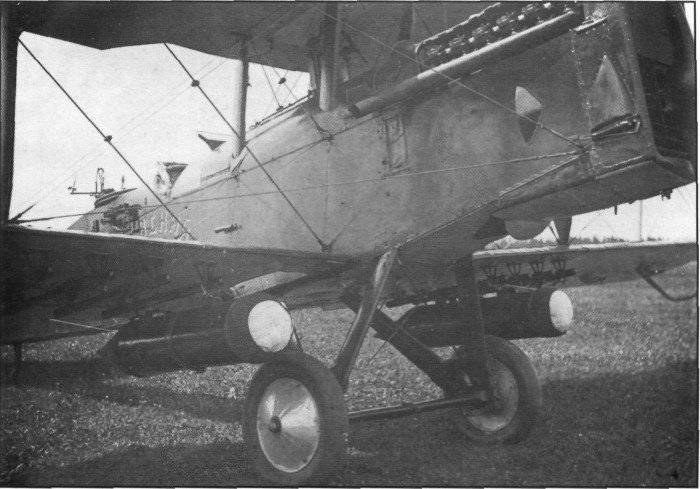
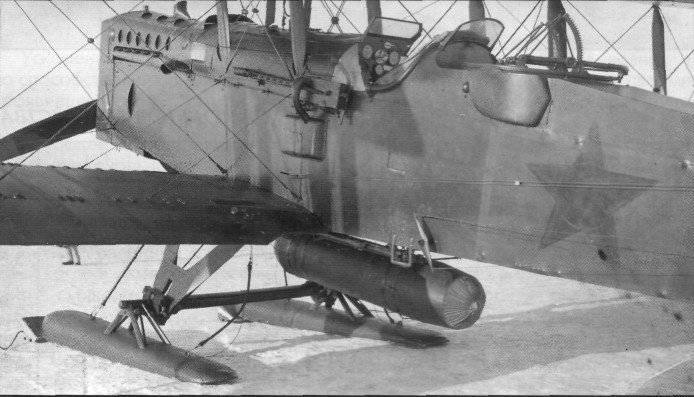
Turbocharger attached to the submotor frame. Covering the fuselage at the exhaust pipes covered with a steel sheet with asbestos gasket. It was also necessary to make changes to nosing. Motorcycle weight increased by 60 kg.
The first flight of the P-1 with turbocharging took place on 23 July 1935, the pilot piloted the car Kaverin, and Pavlyuchuk was sitting in the cabin of the Letnab. After landing, the pilot turned off the ignition, but the engine did not stop. We tried to turn on the ignition again - a fire started in the supercharger; but when Kaverin gained momentum, the fire went out.
In further flights, such troubles are no longer met. Revealed only excessive release of oil from the bearings of the turbocharger. In total, until October 21, the pilots Kaverin, Uronichev, and Dolgov made 17 flights with various flyers. The experience of exploring the American device was later used in the development of the first domestic turbochargers.
IN CIVIL AVIATION
At the end of the 20-s, a certain amount of P-1 was transferred to civil aviation. All weapons and military equipment were removed from them and used as training and postal equipment under the designation П-1. For the first time on these planes the transportation of the Pravda matrices to other cities was organized. By order of the Chief of the Air Force 15 in May, the 1931 of the civil aviation should have transferred the 55 P-1 with BMW IV engines, but not all of them could already fly. Really, apparently, if they gave, then no more than a dozen cars. The last references to civilian P-1 refer to 1932.
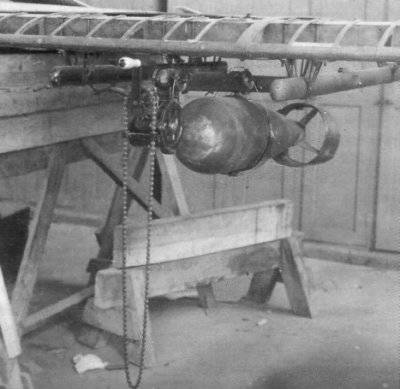
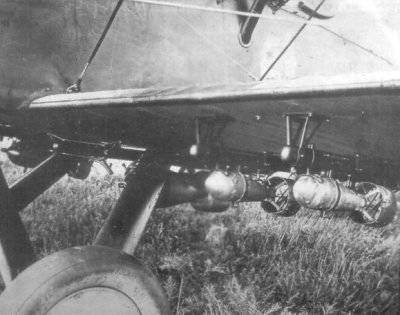

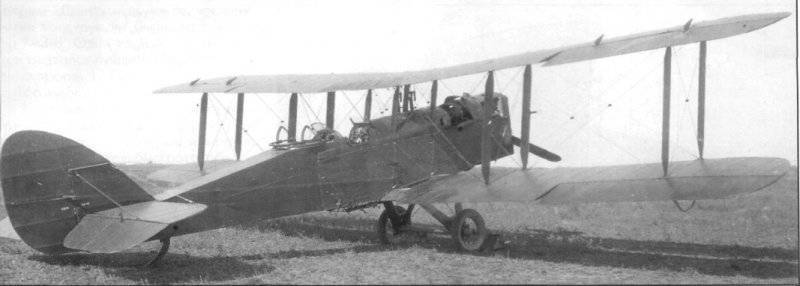
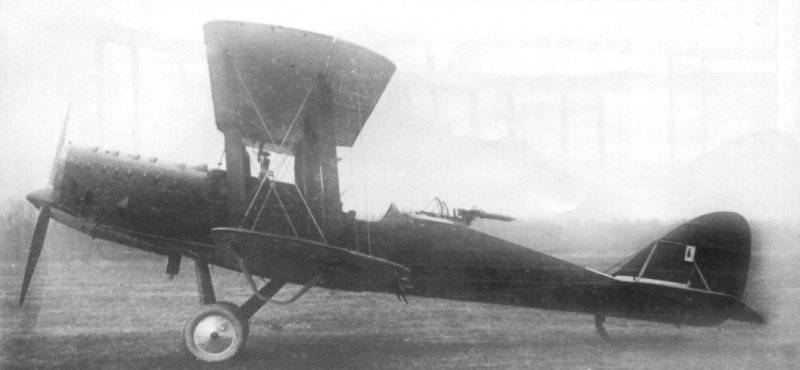
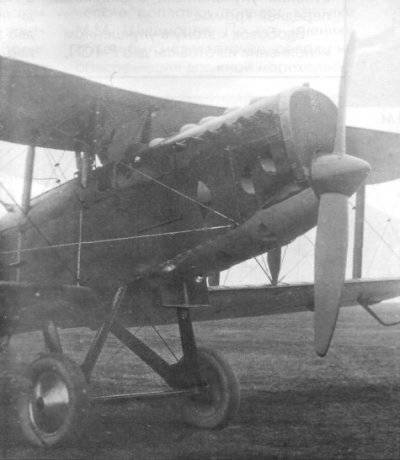
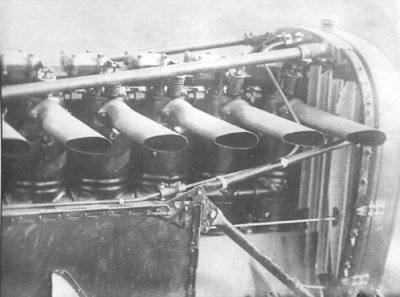
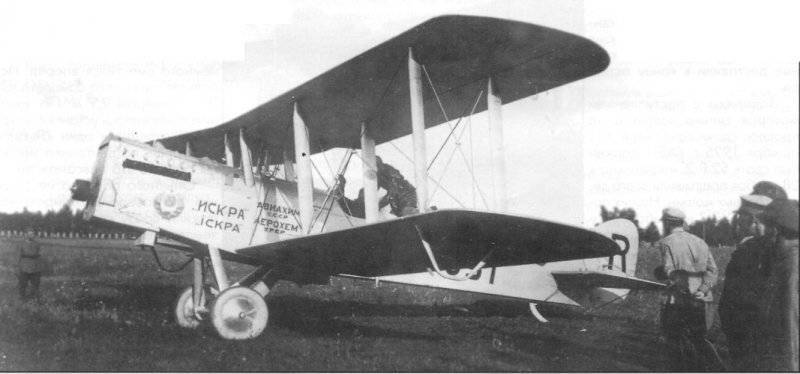
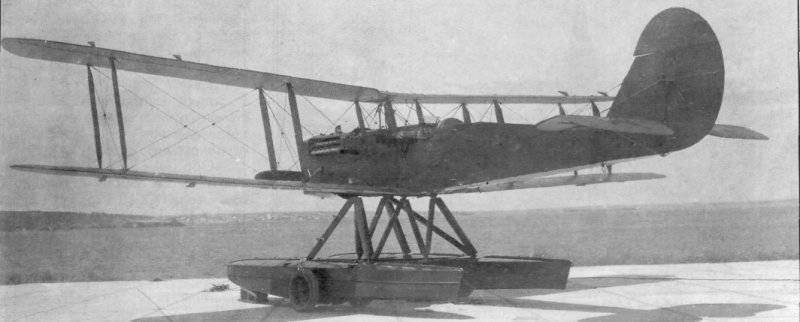
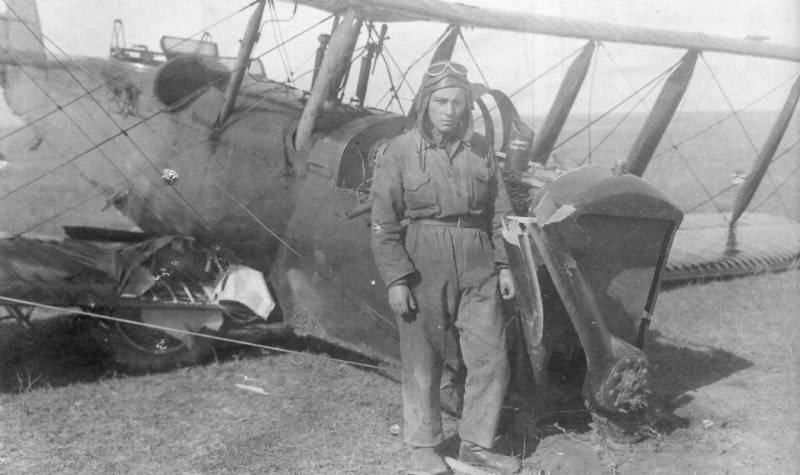

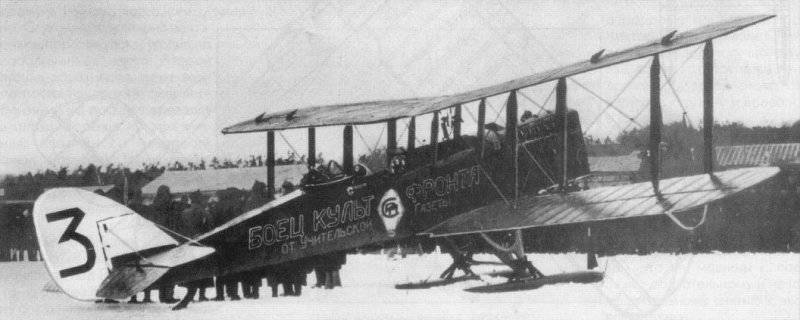
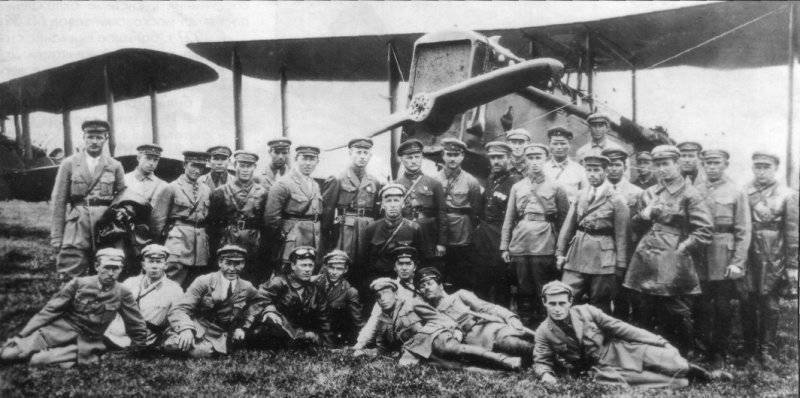
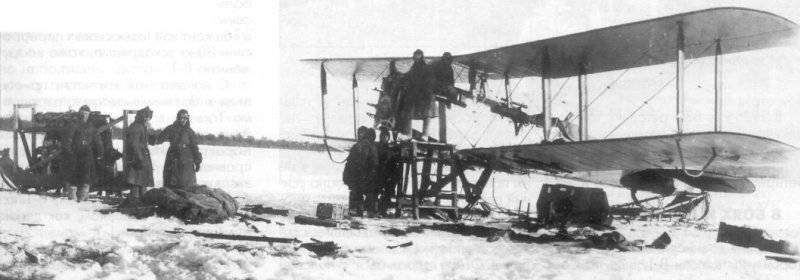
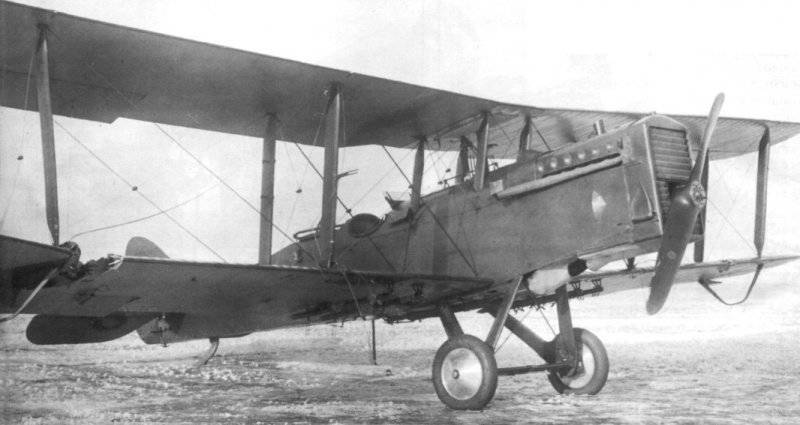
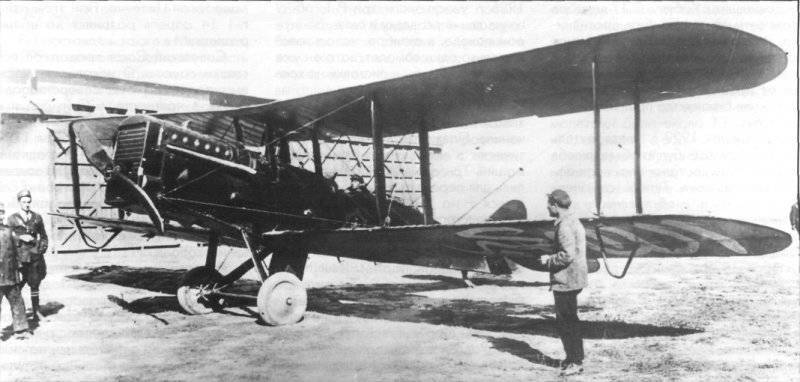
Information